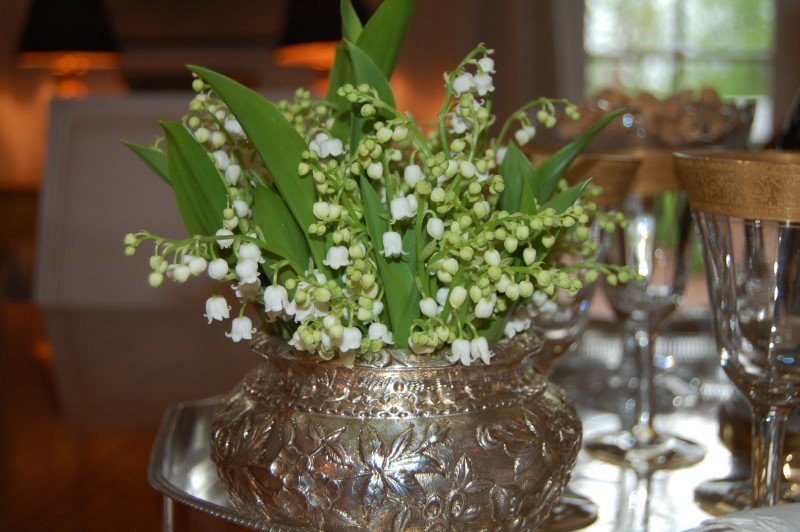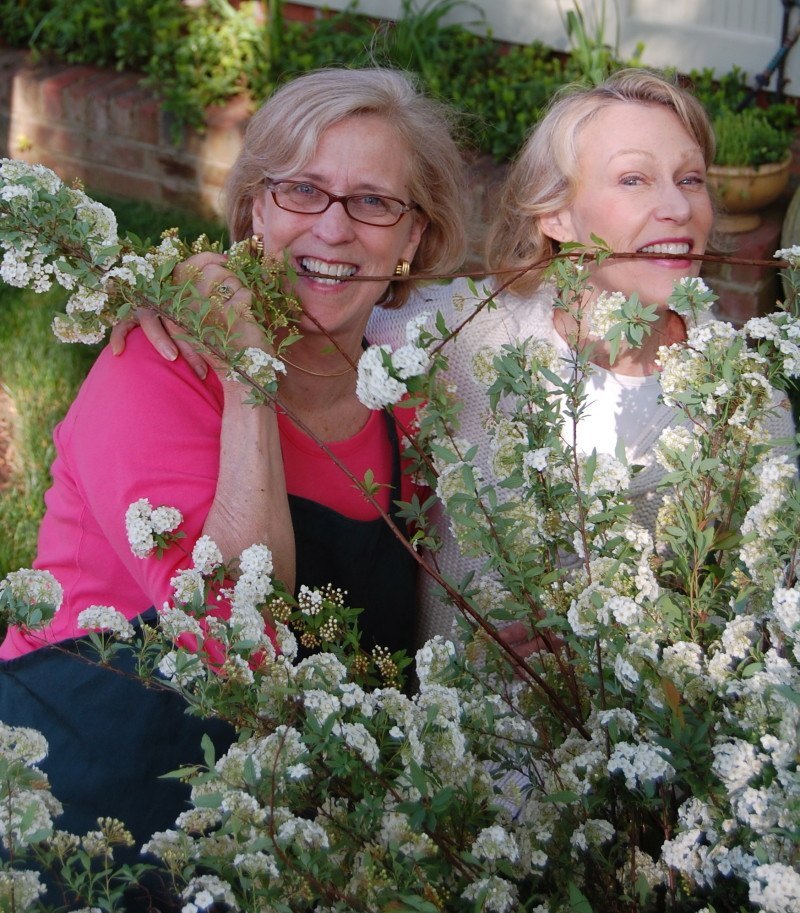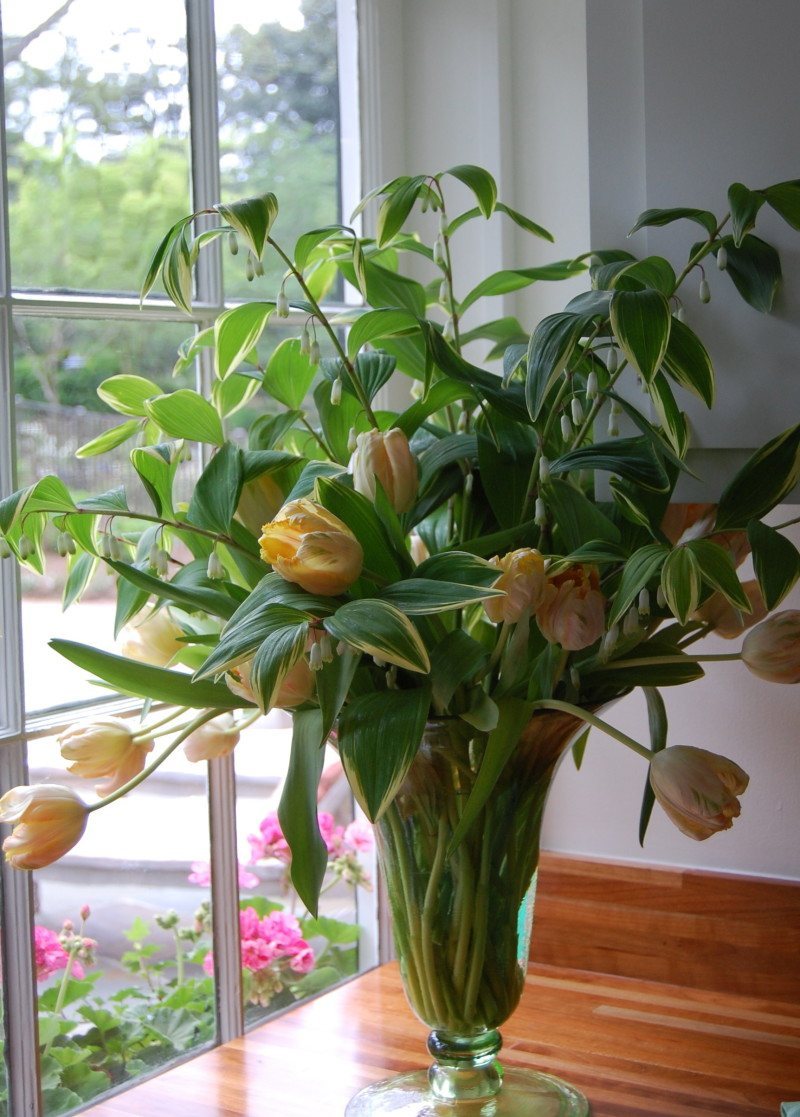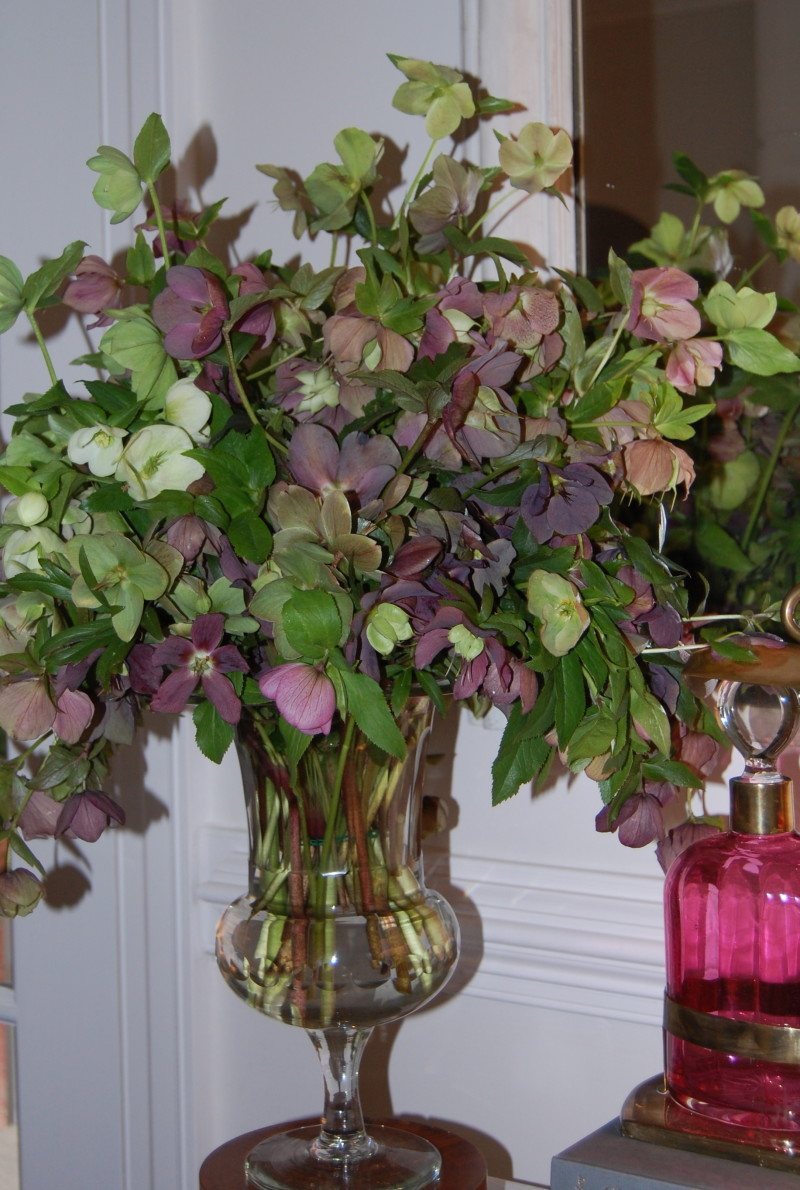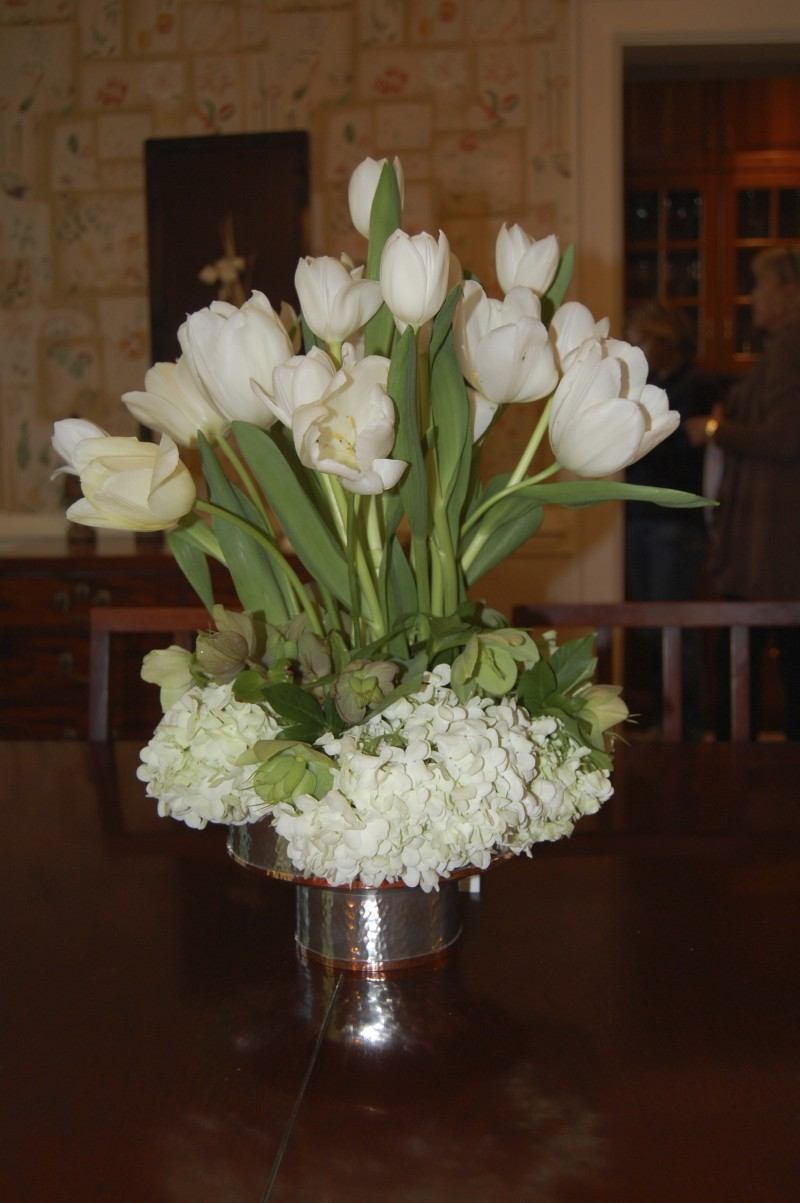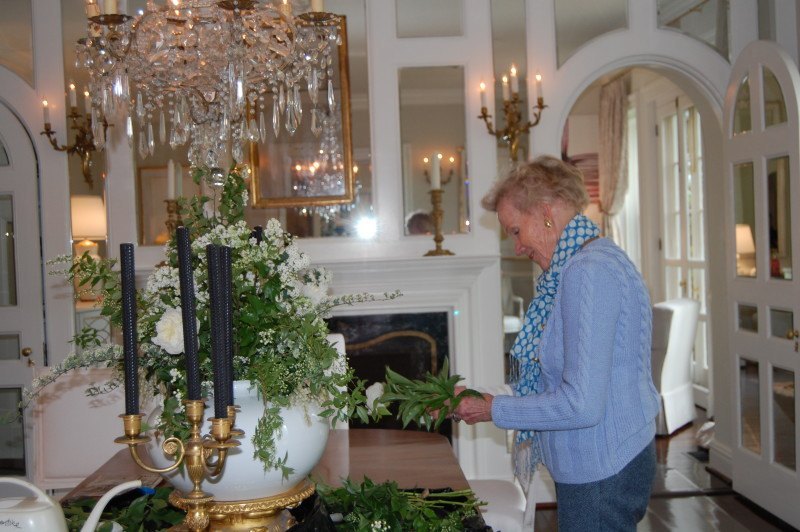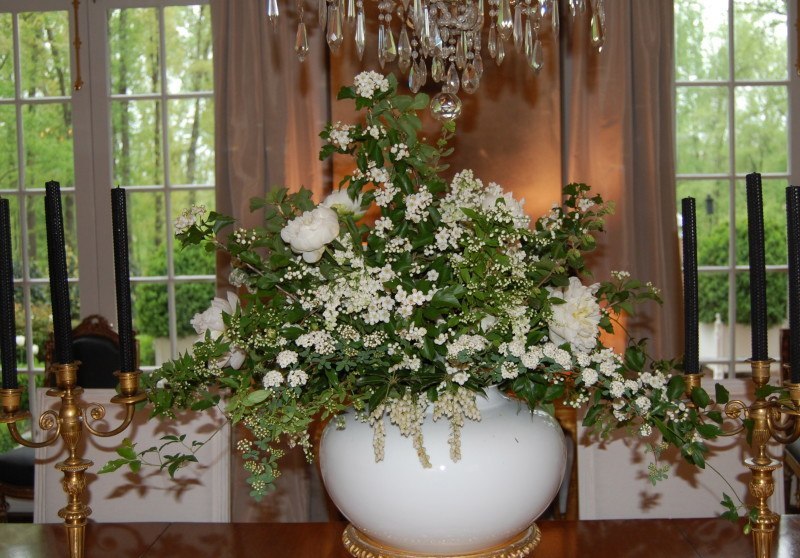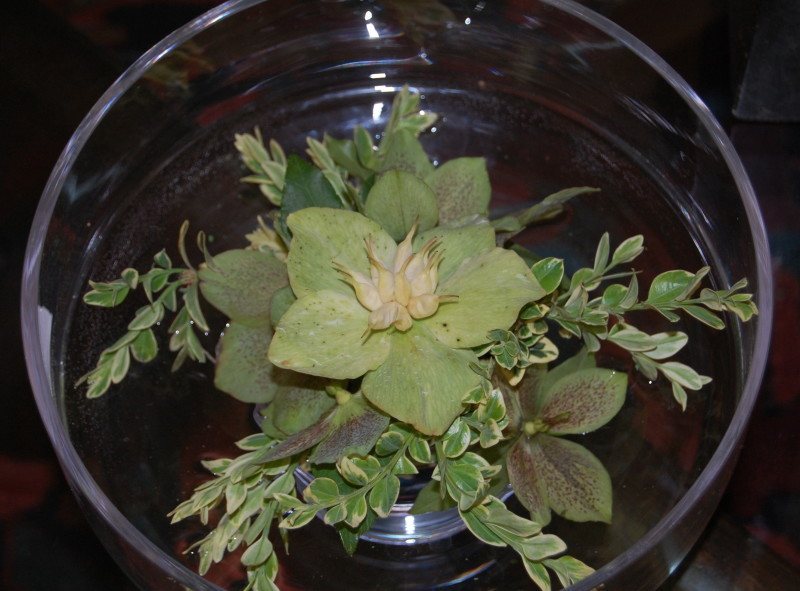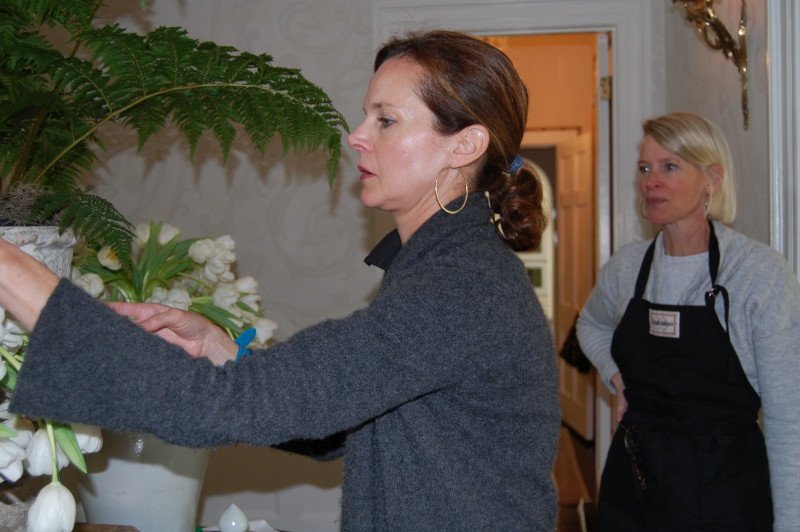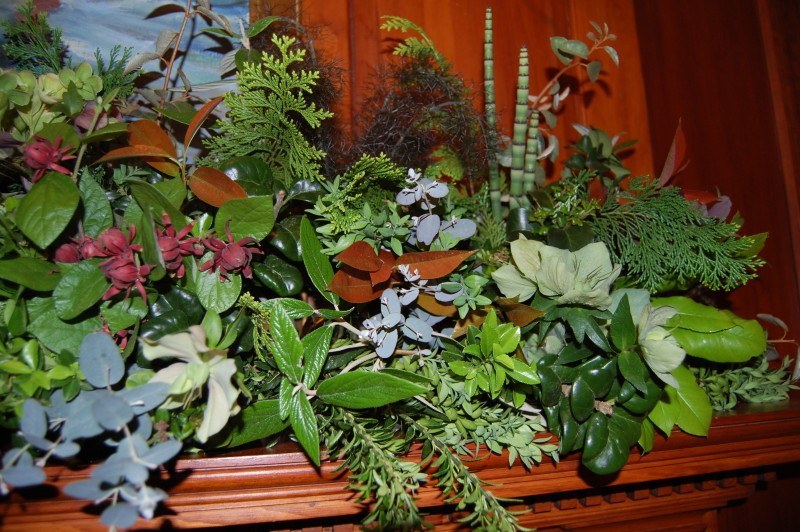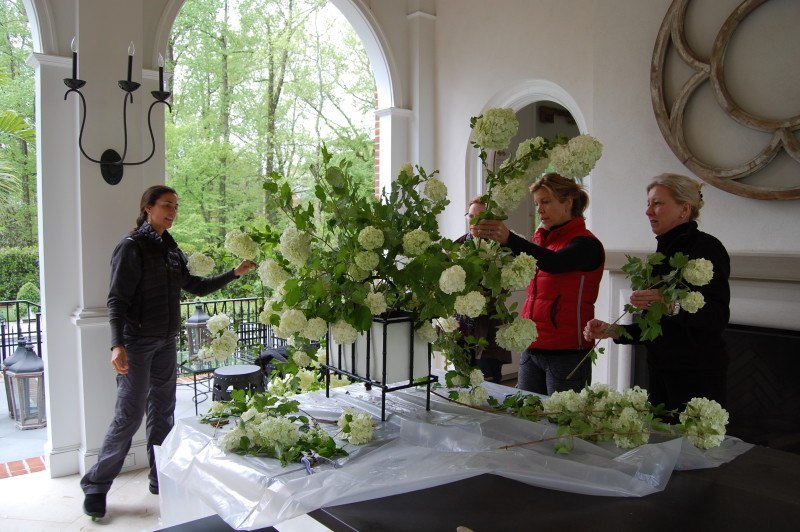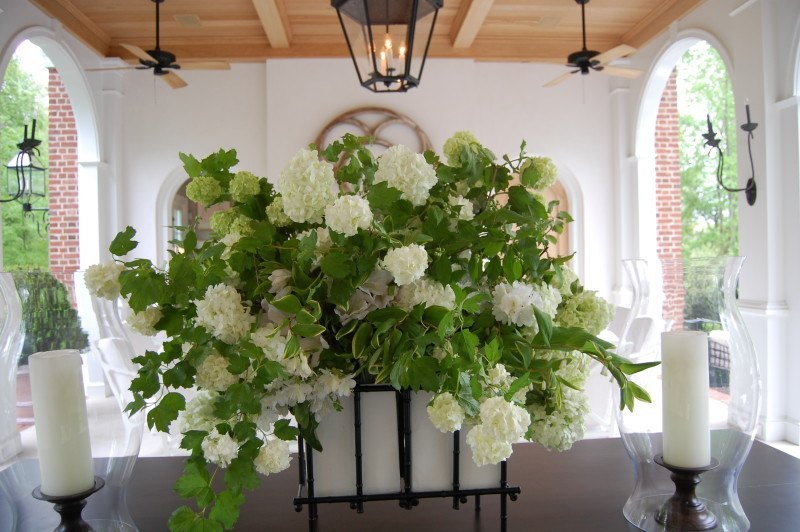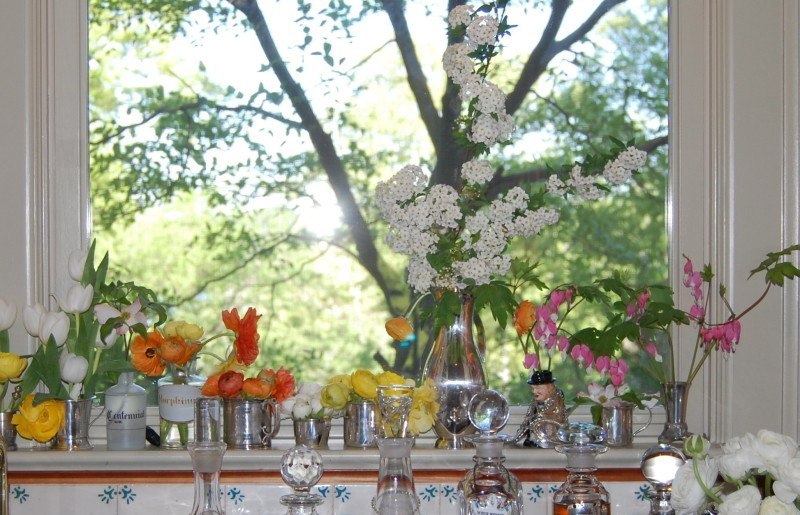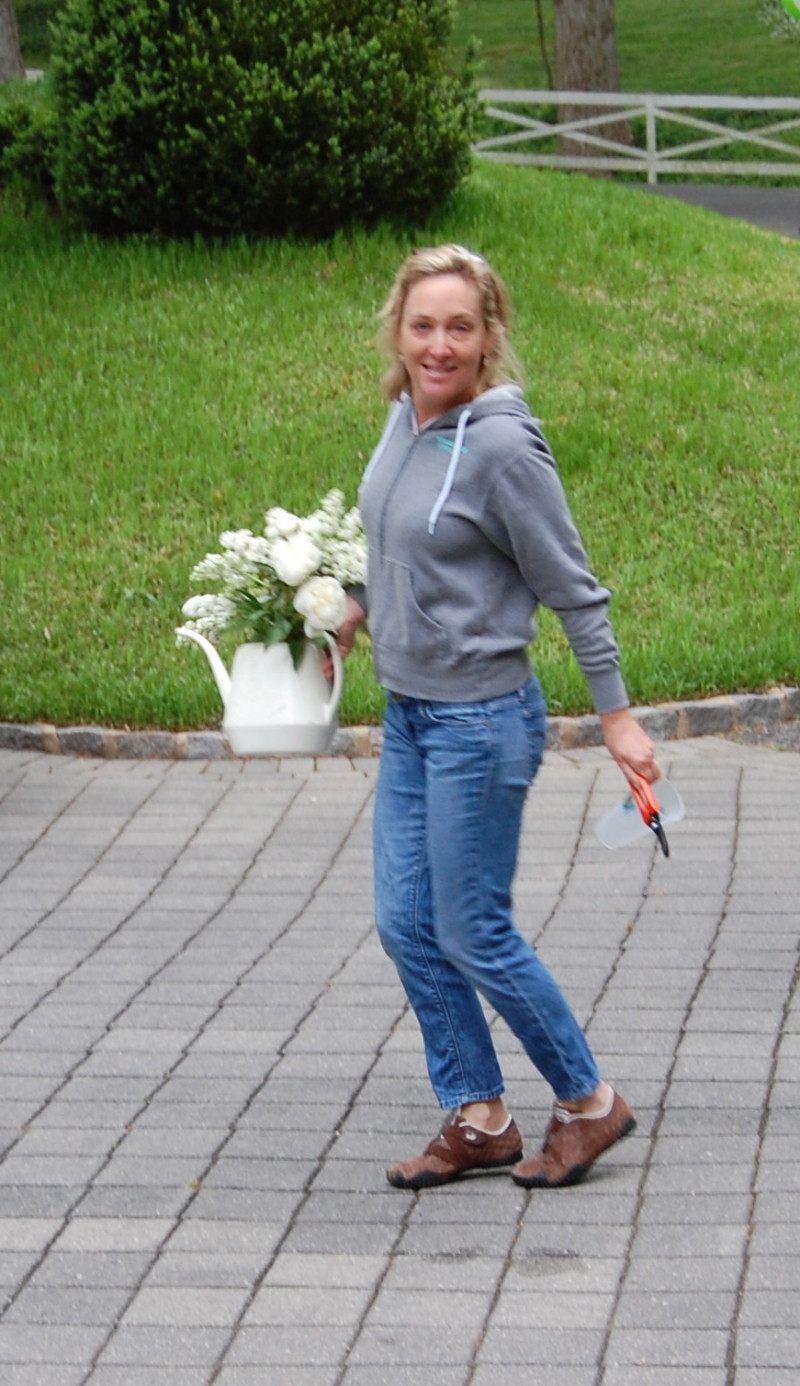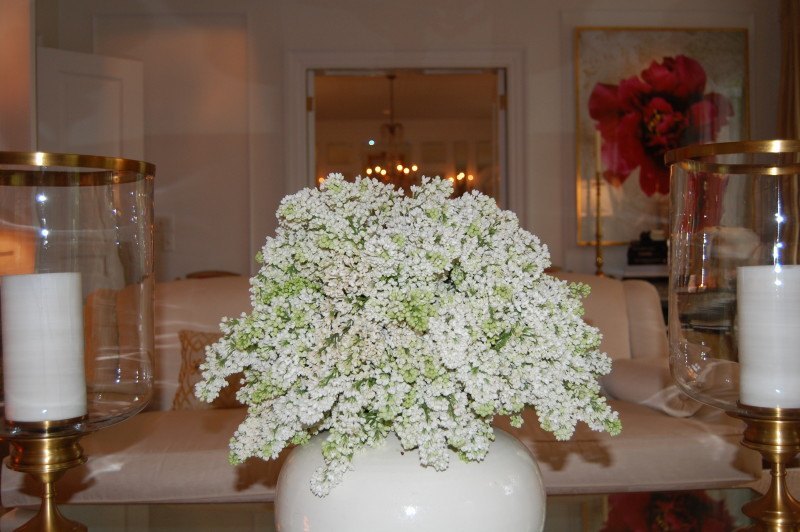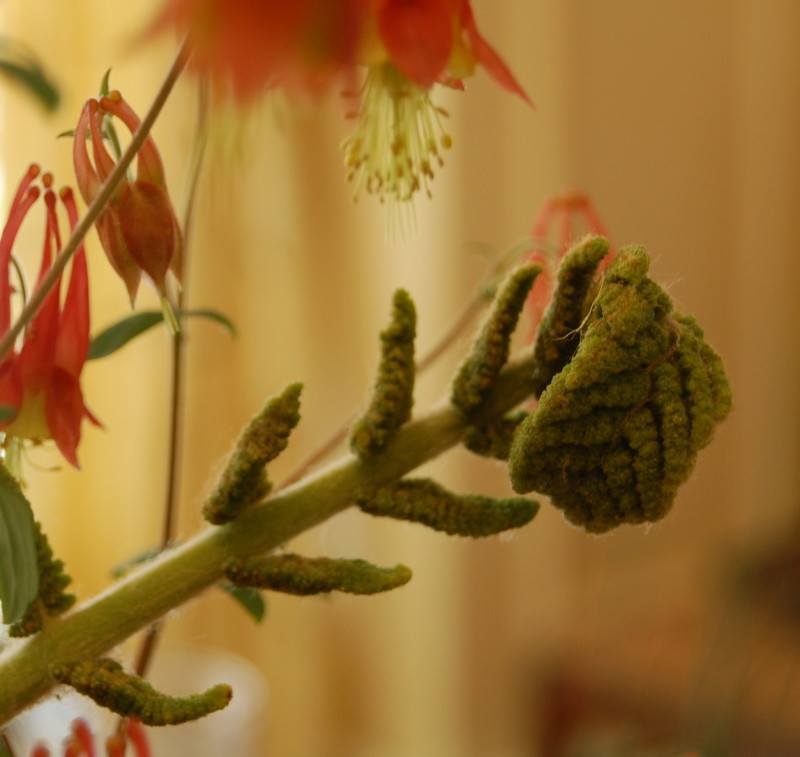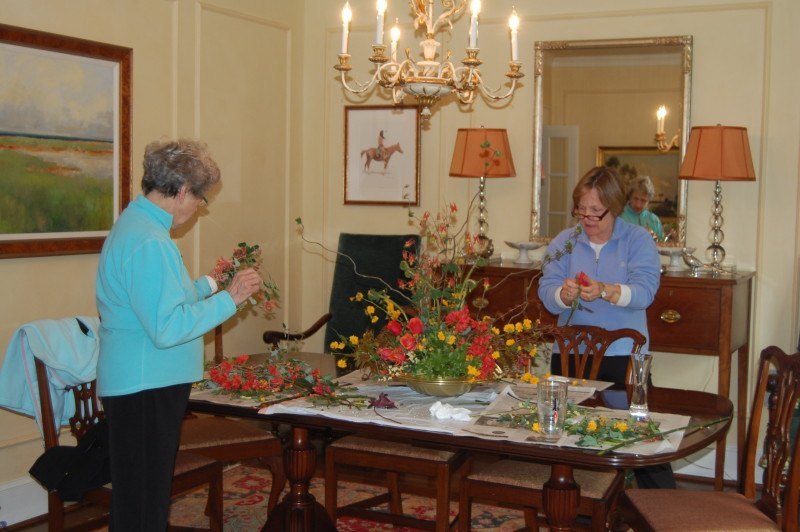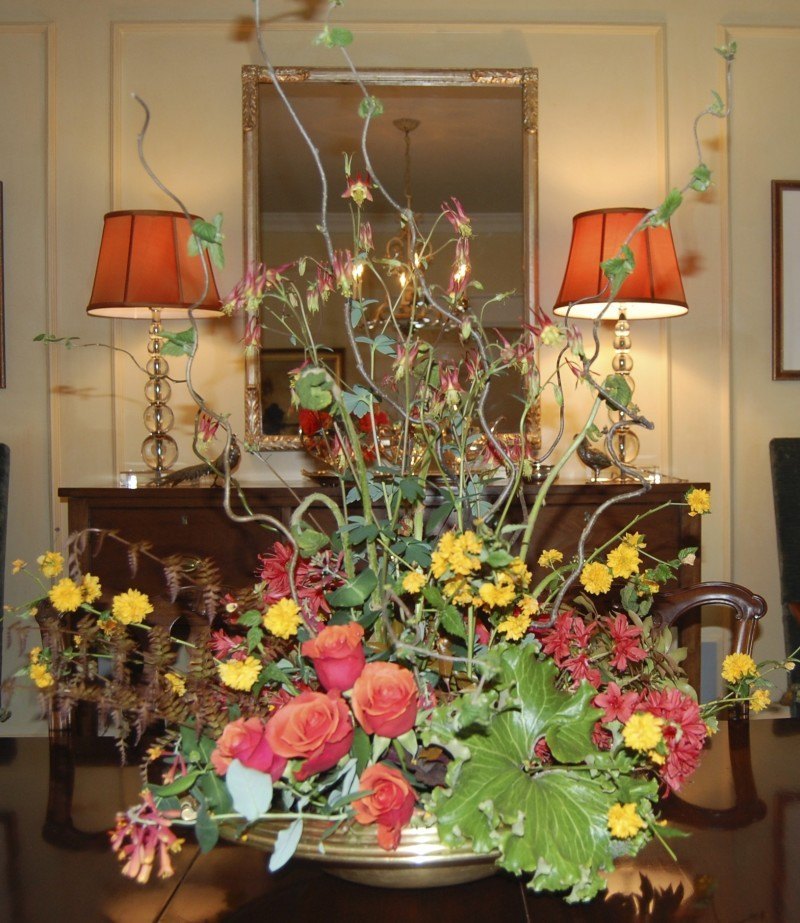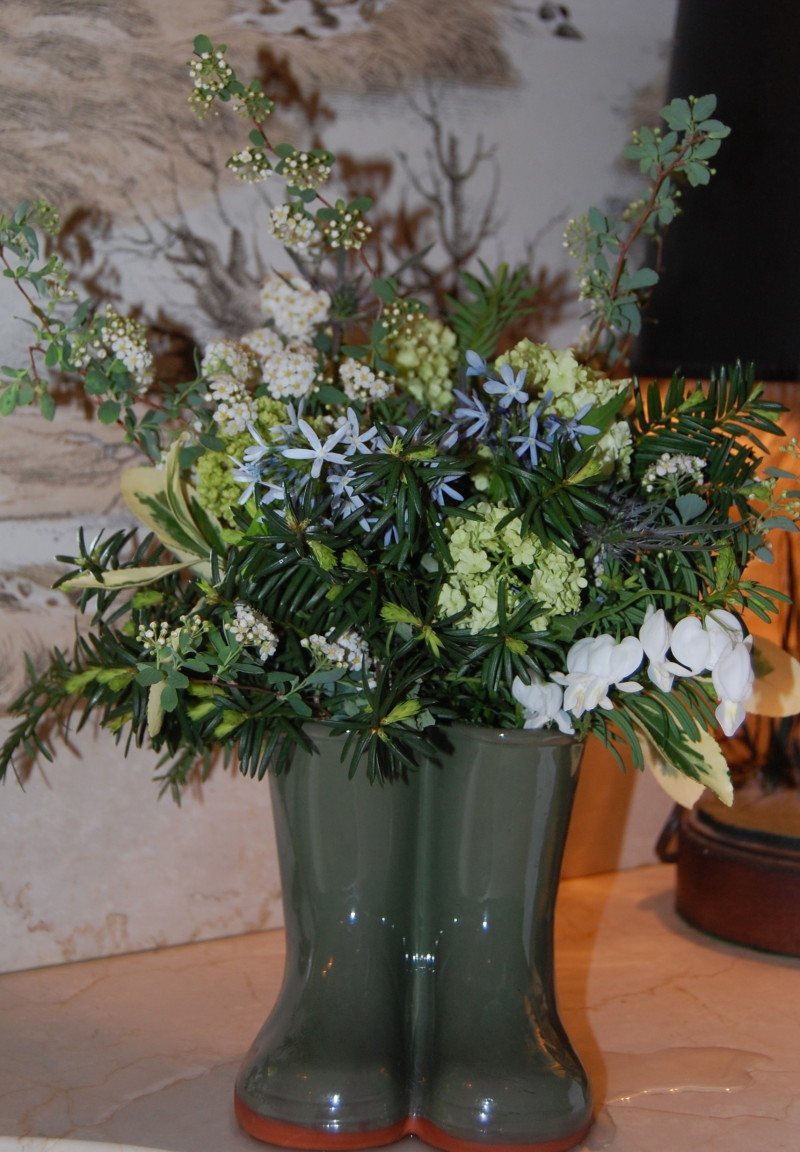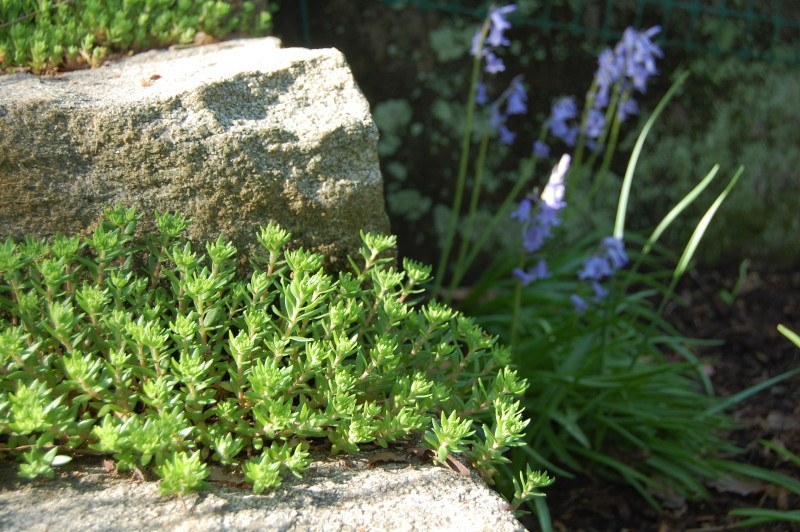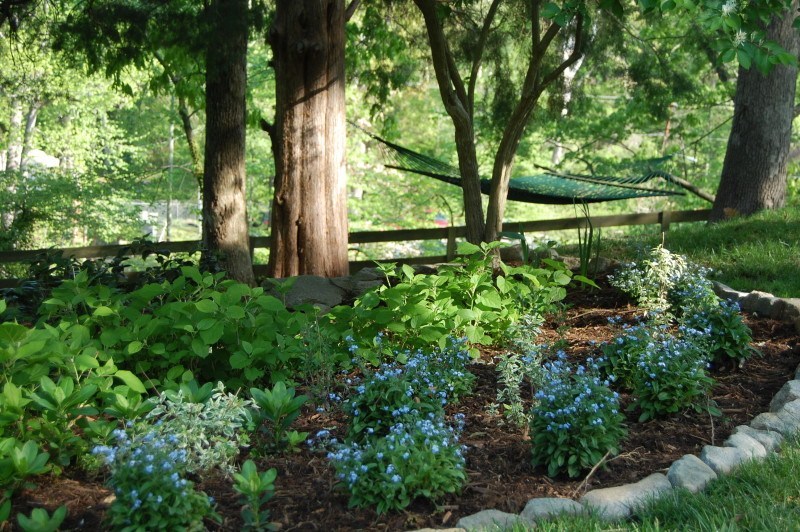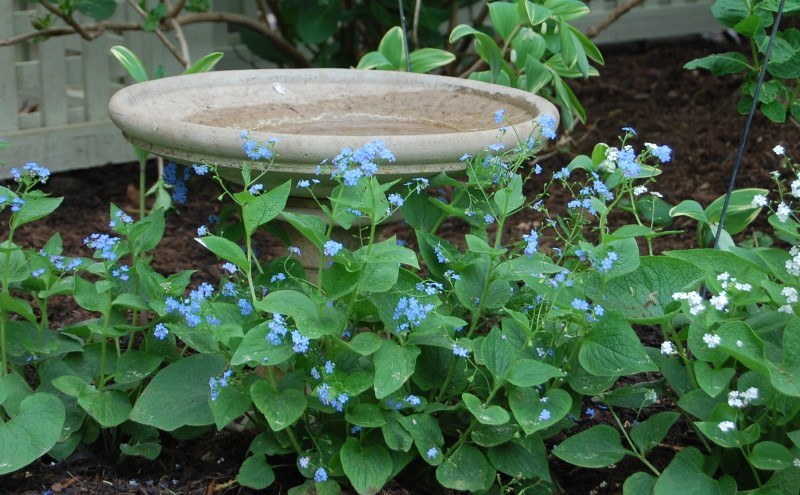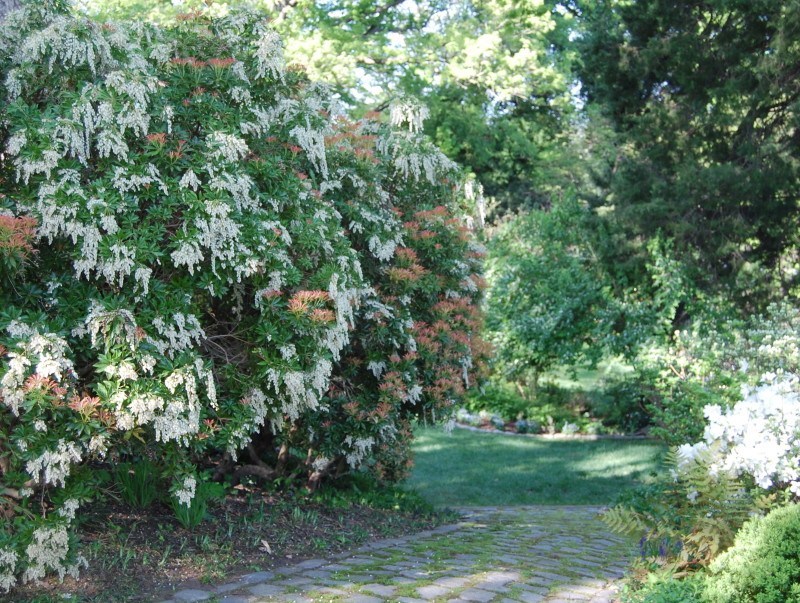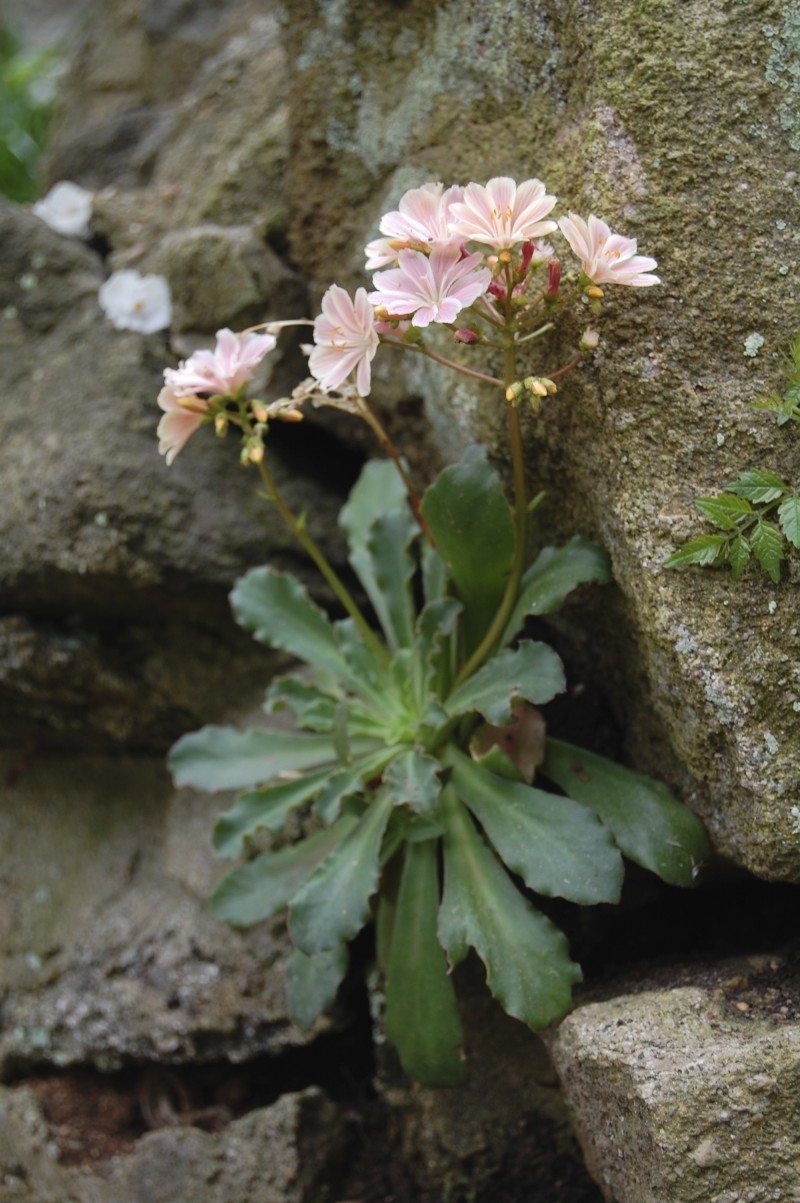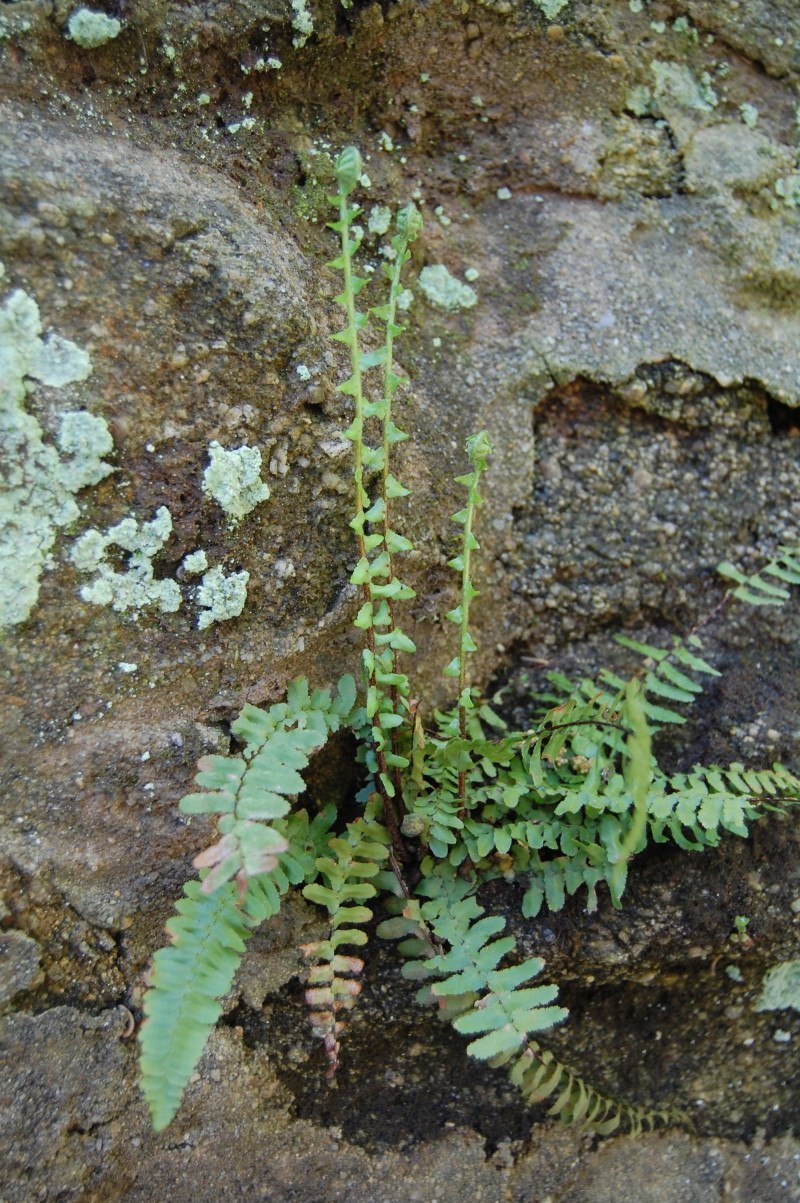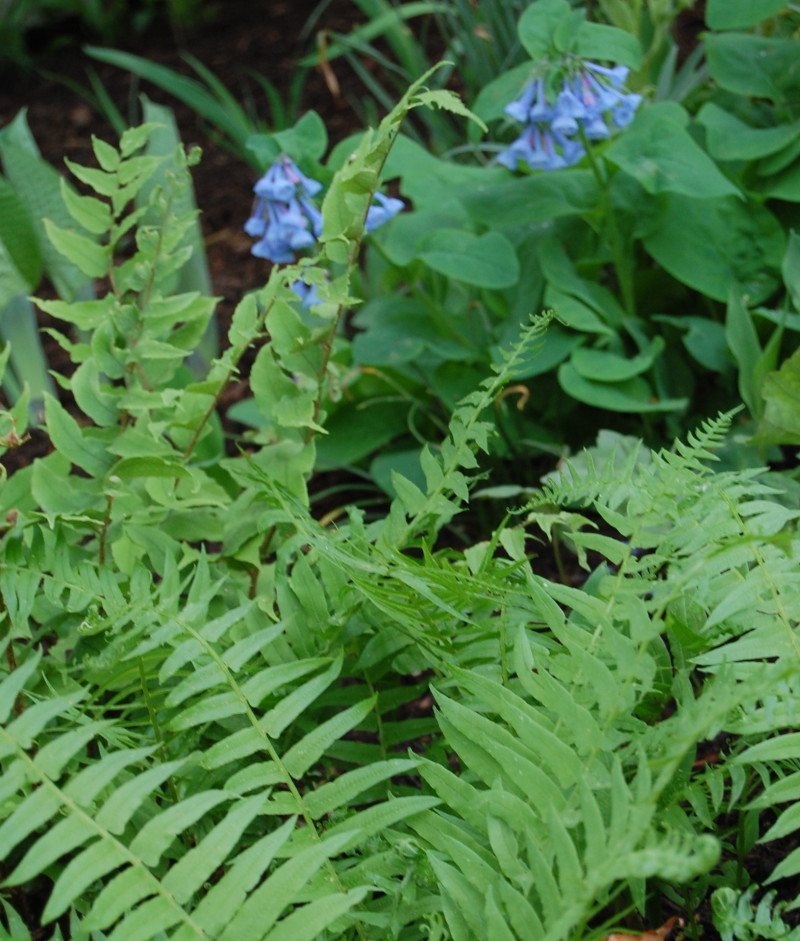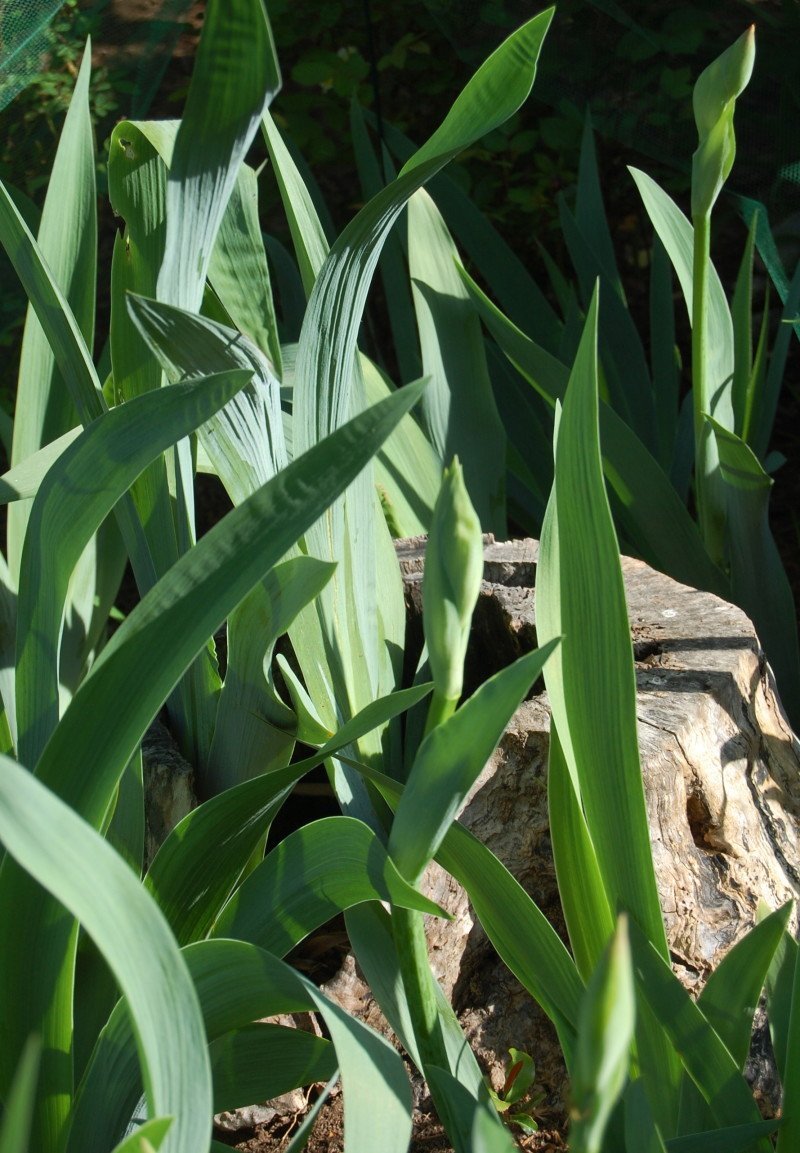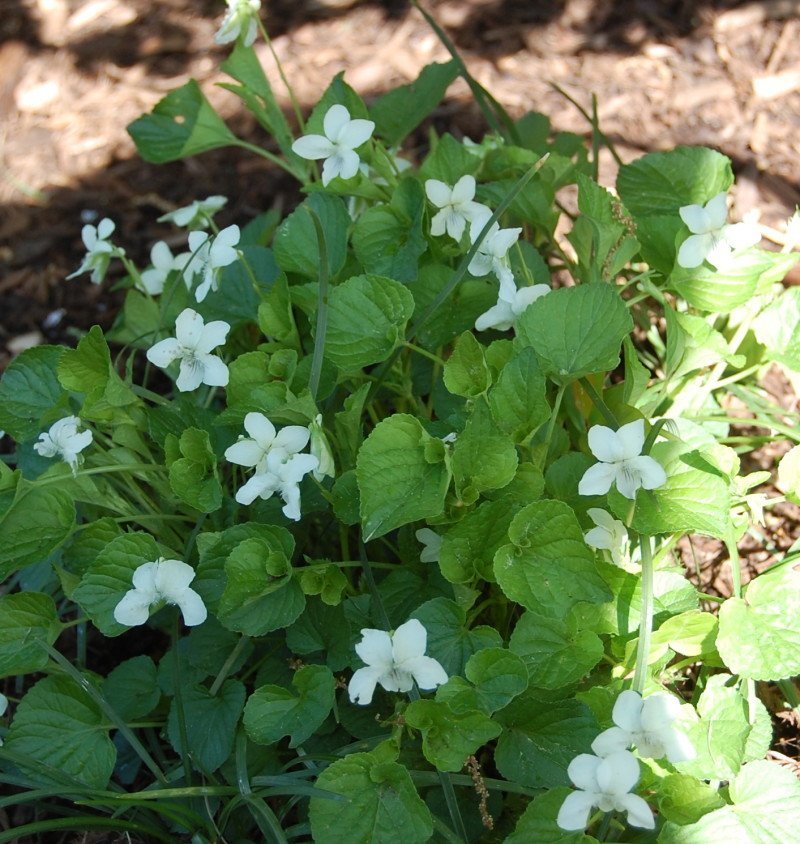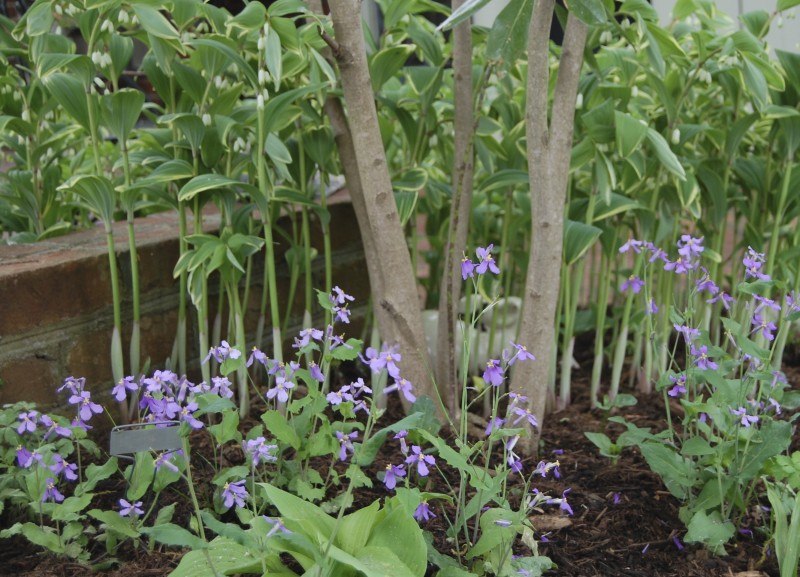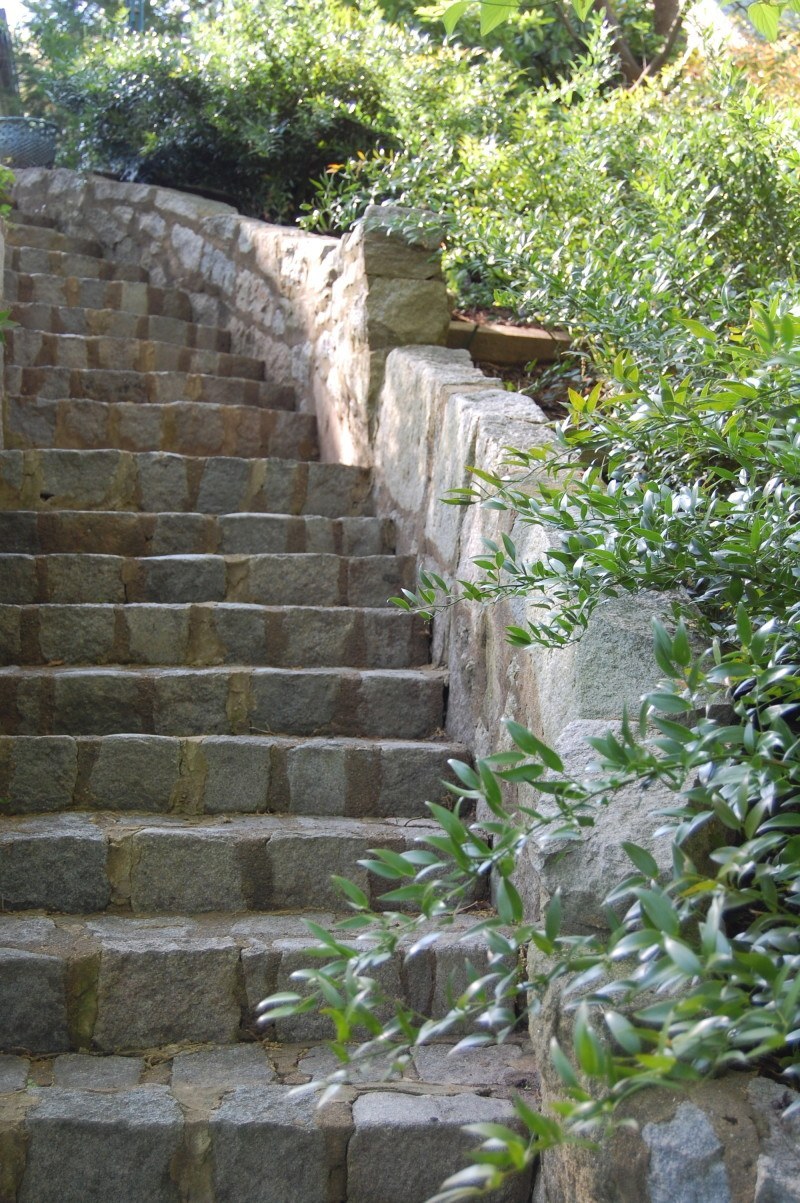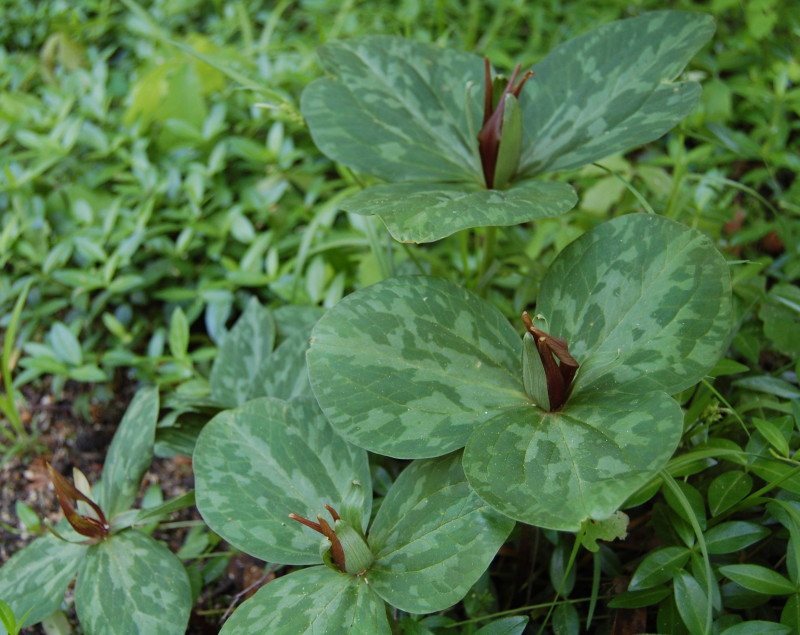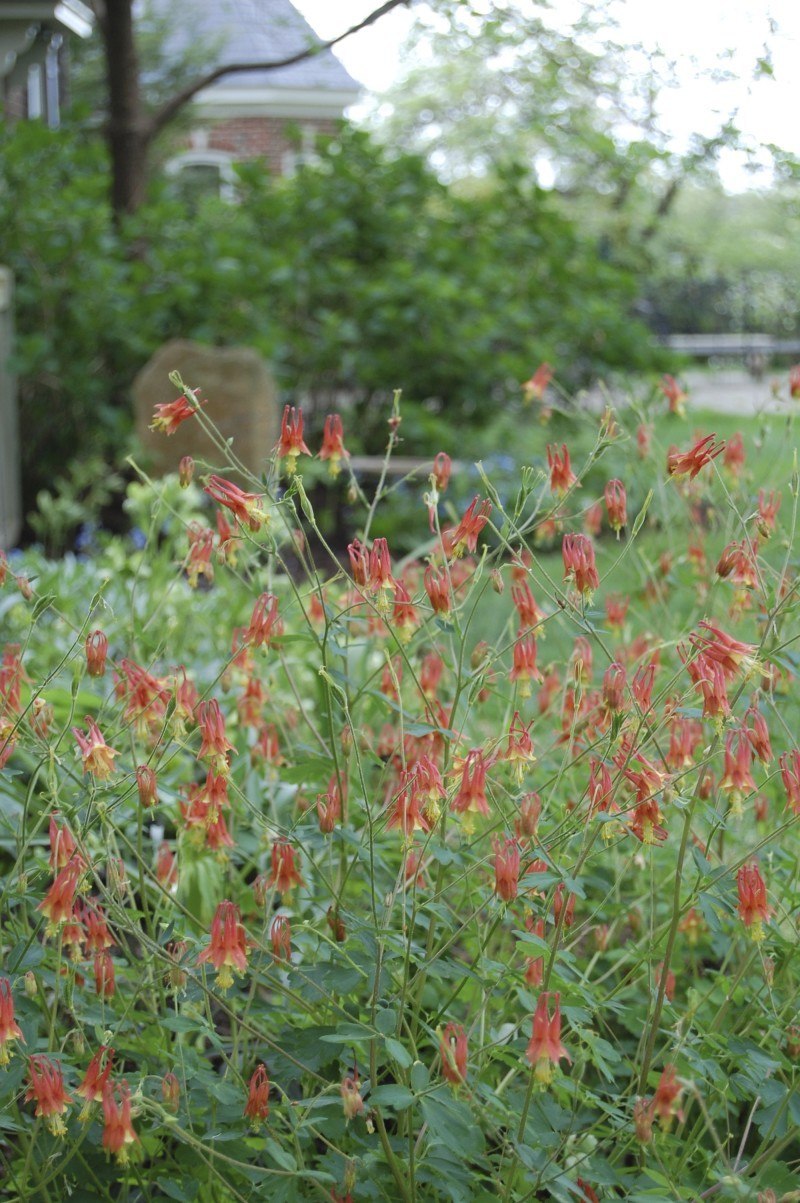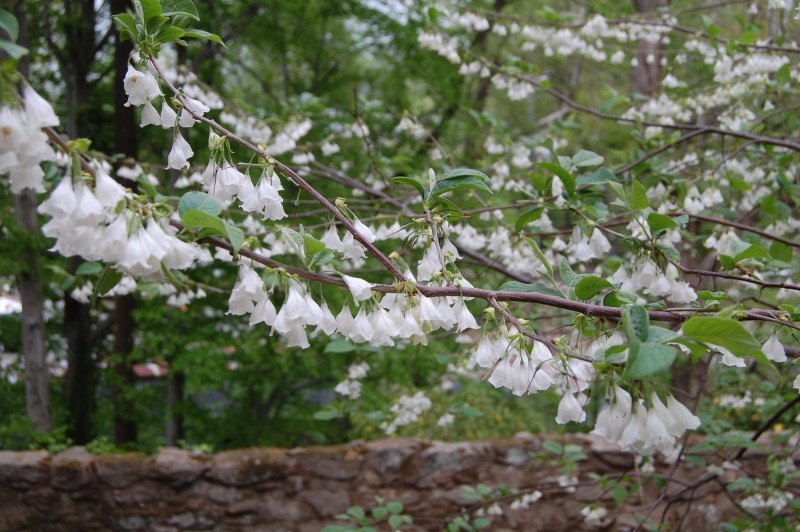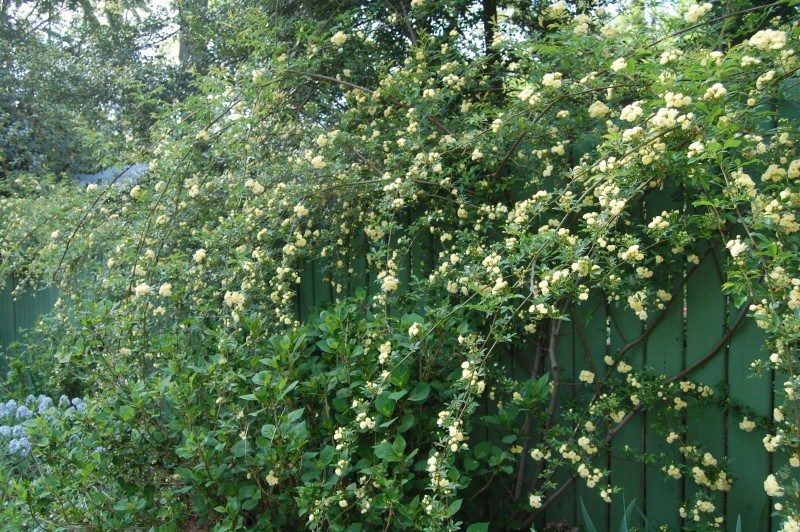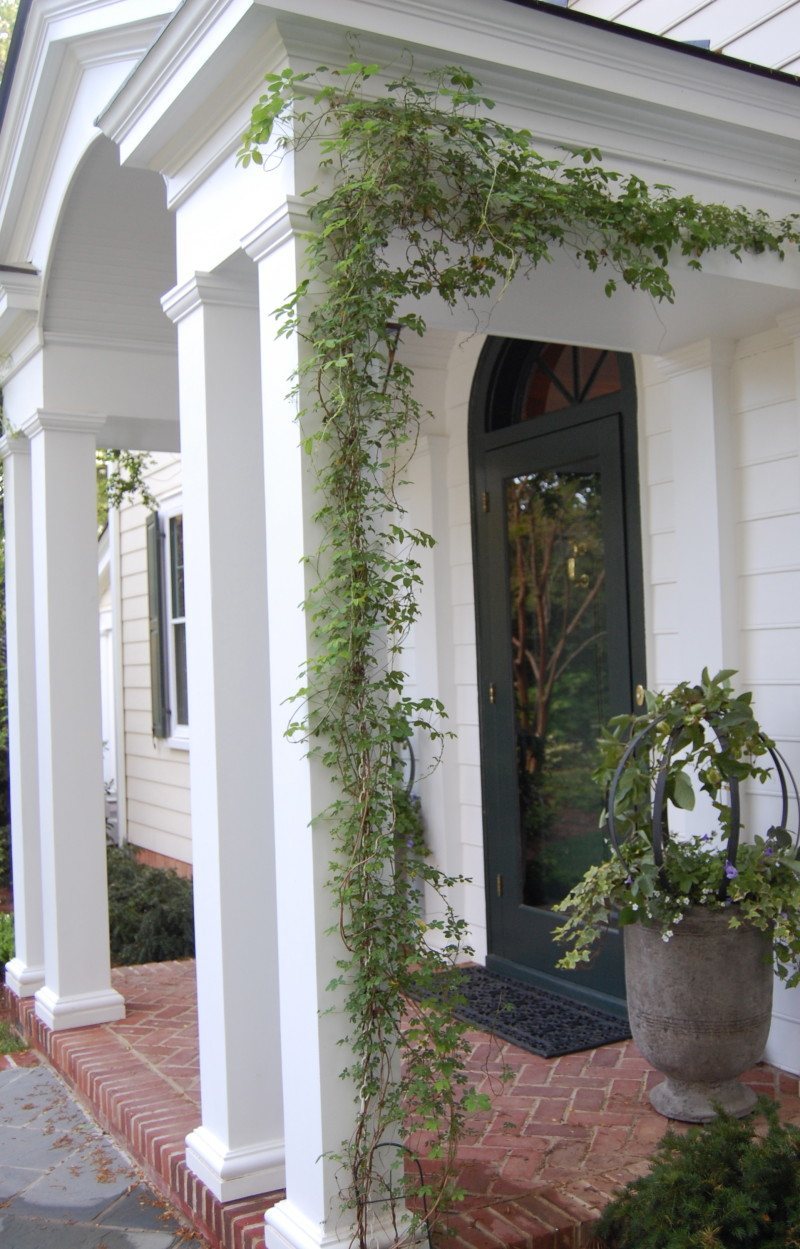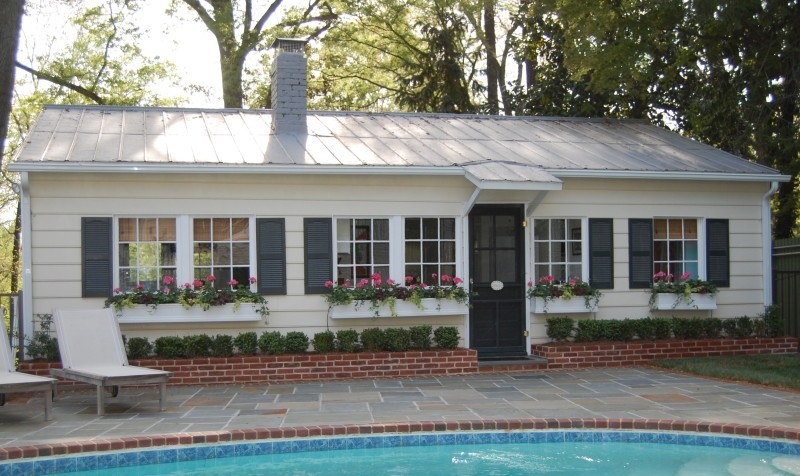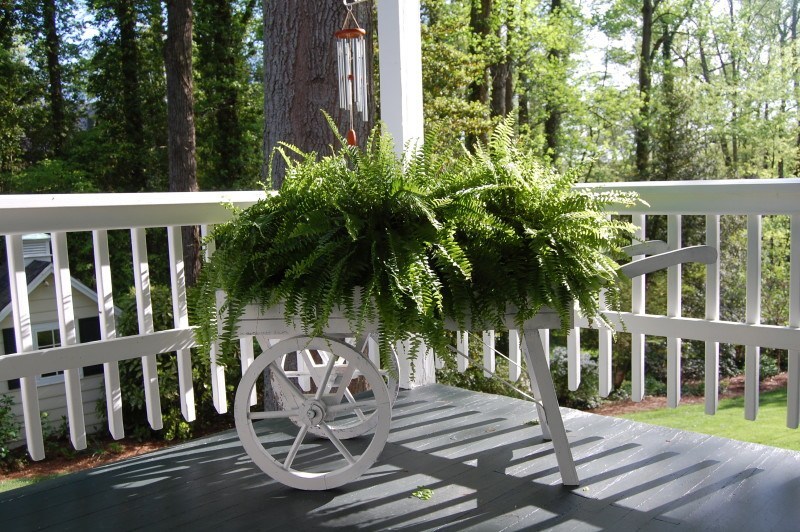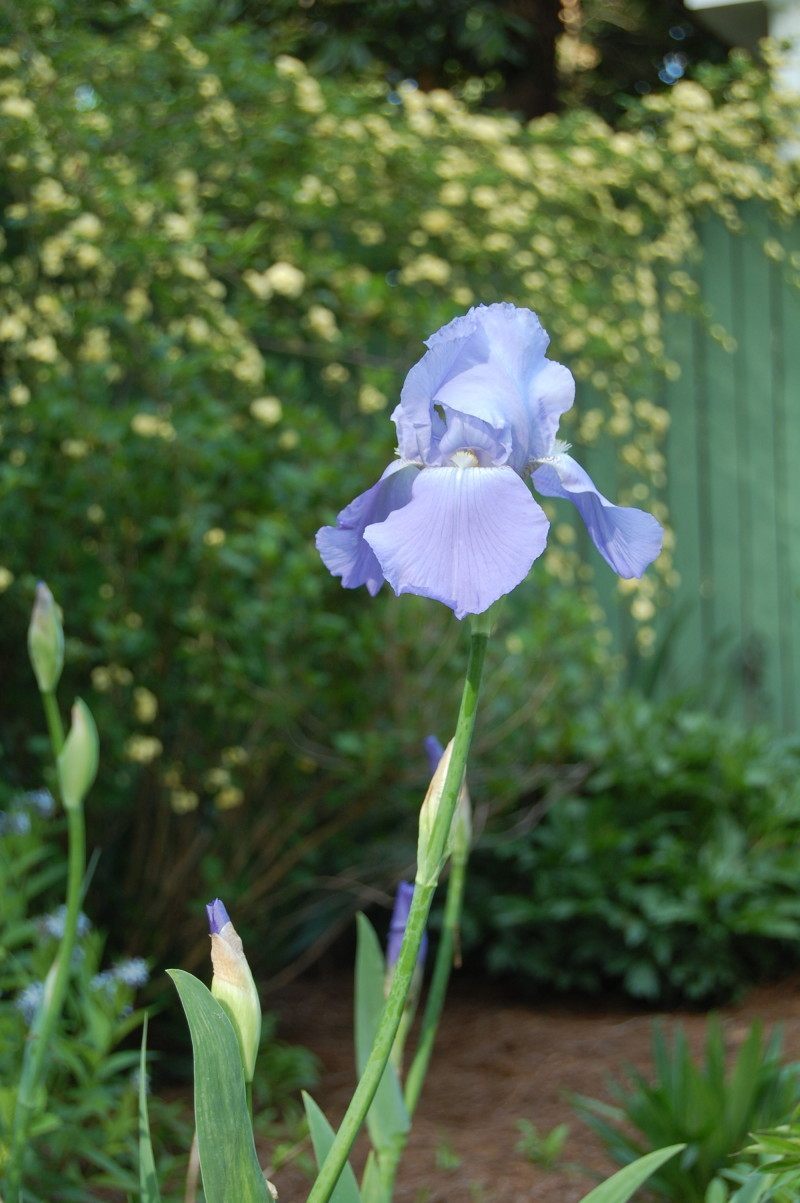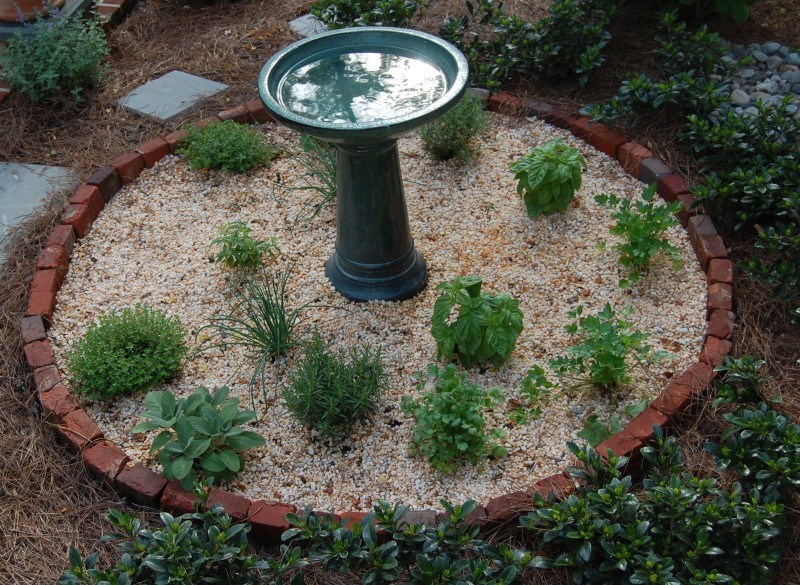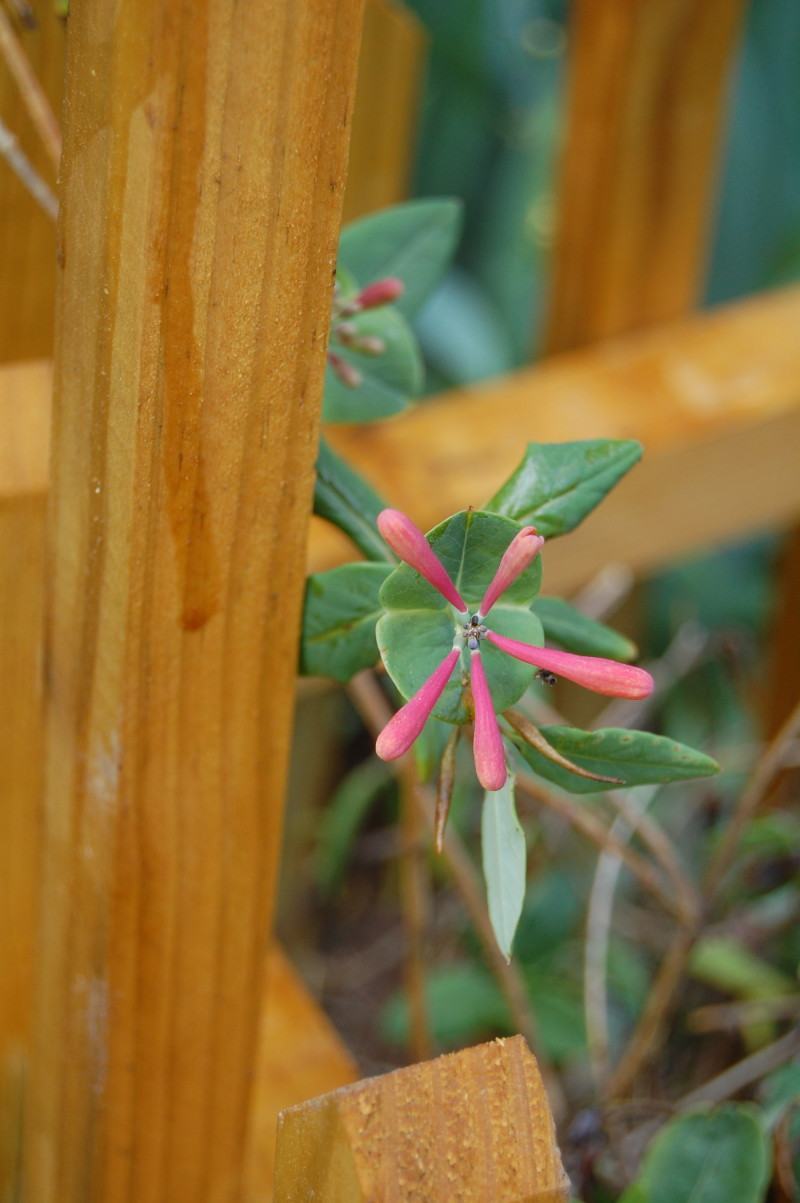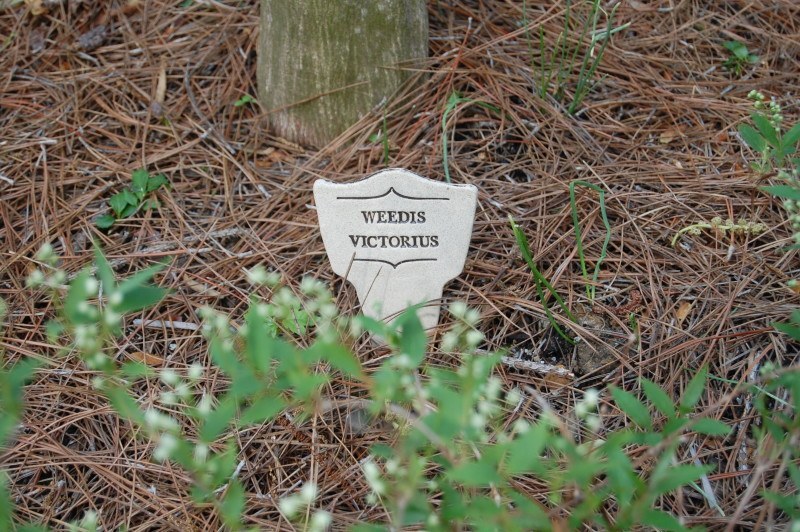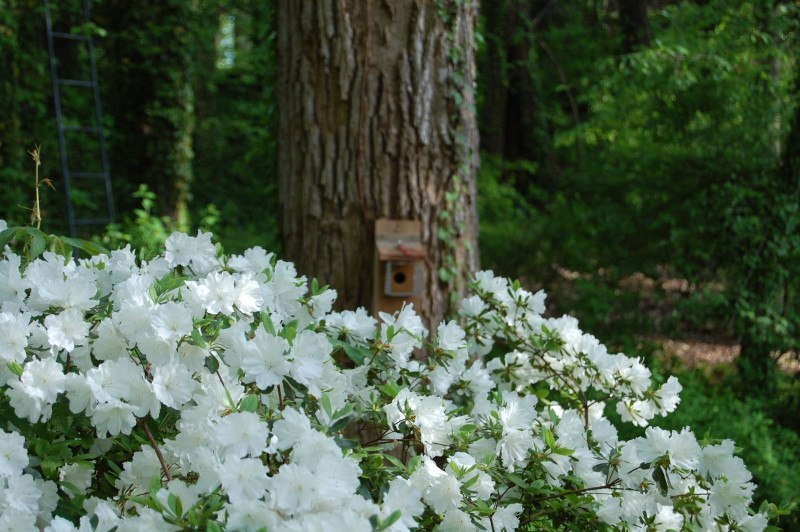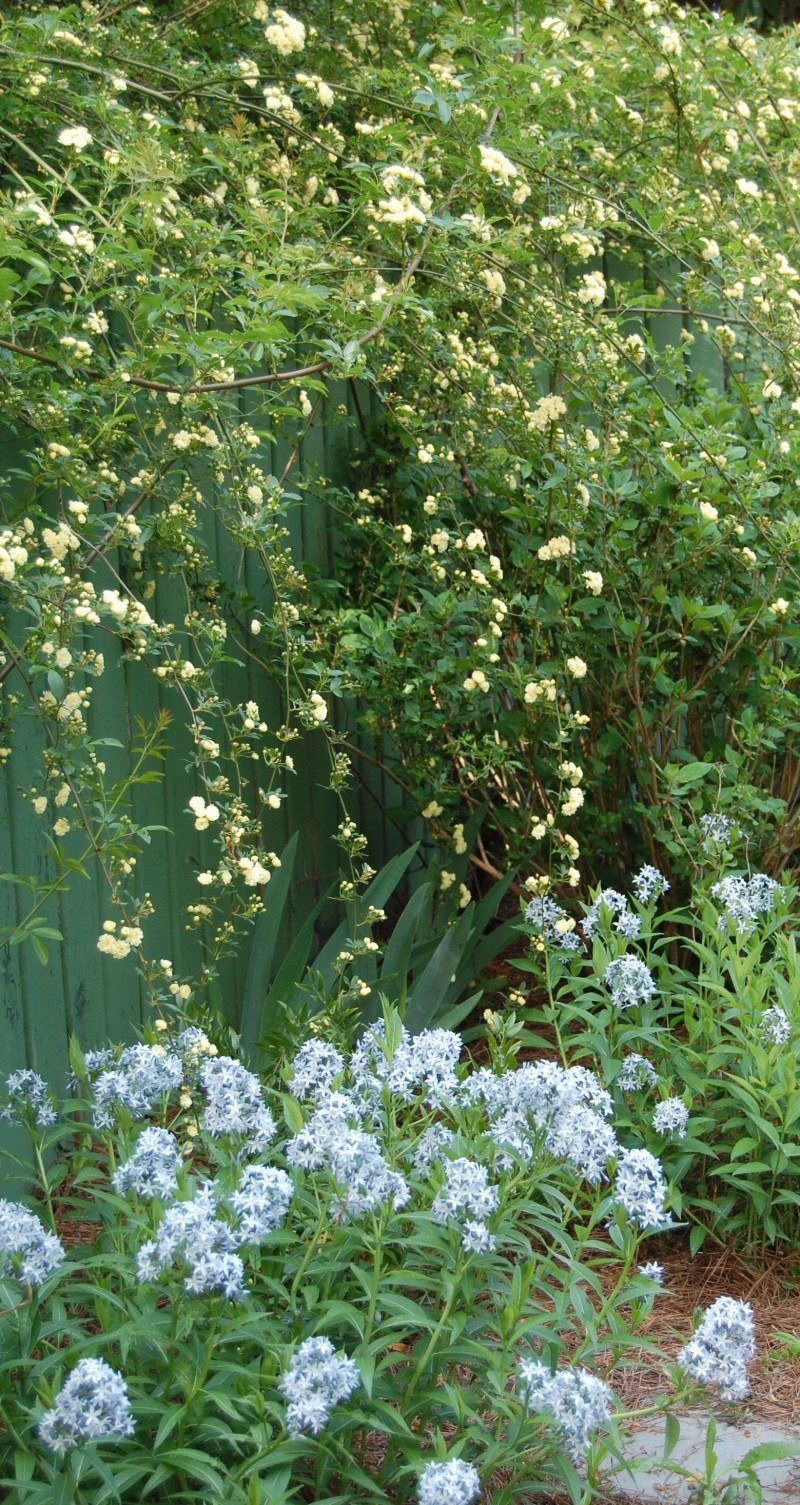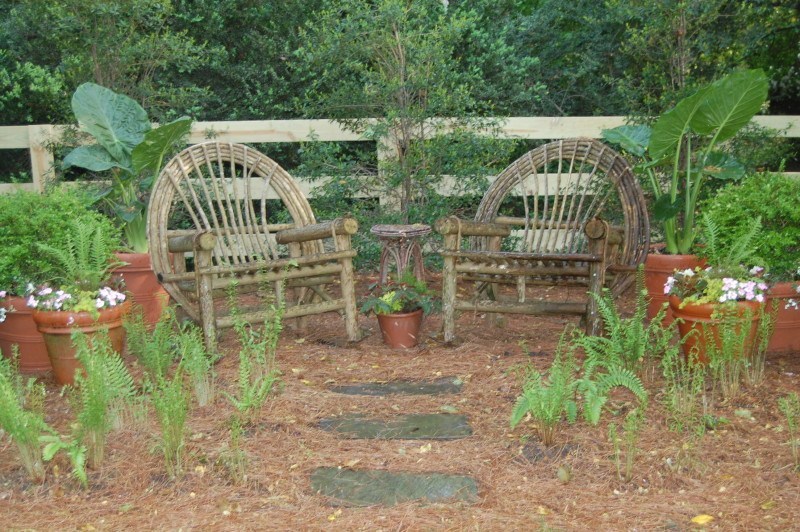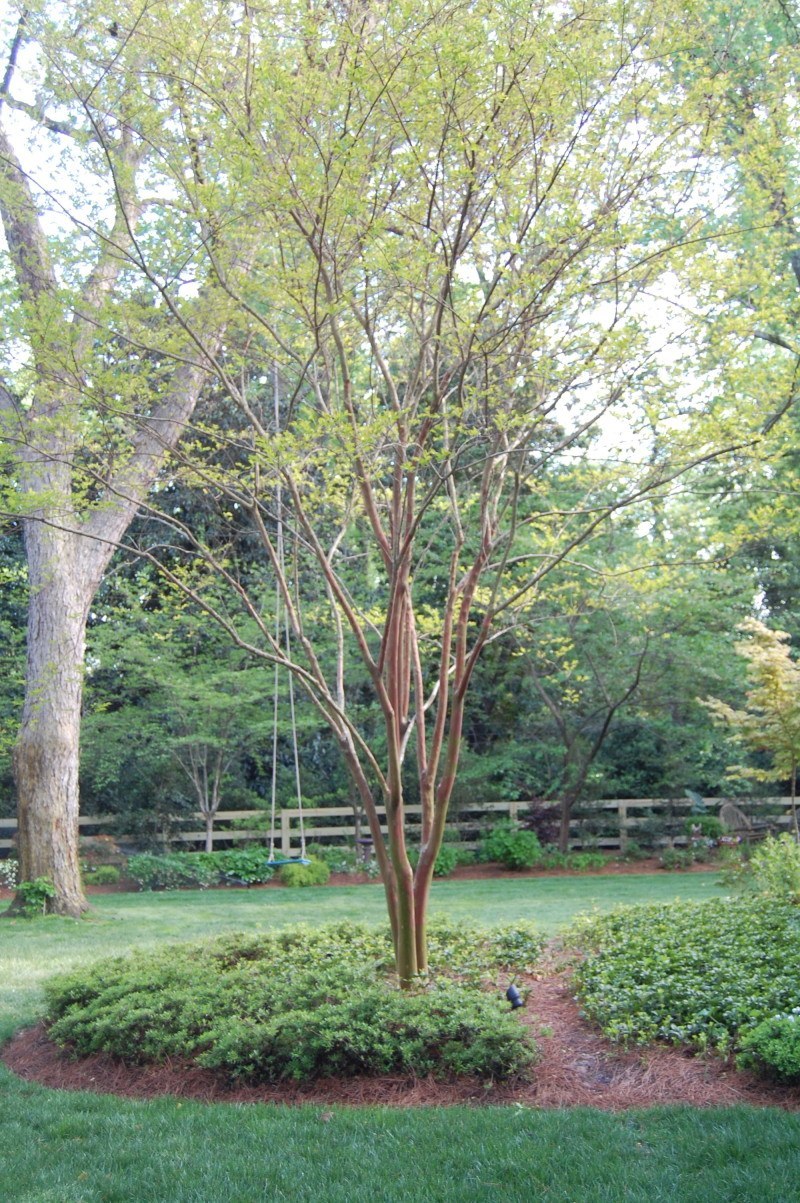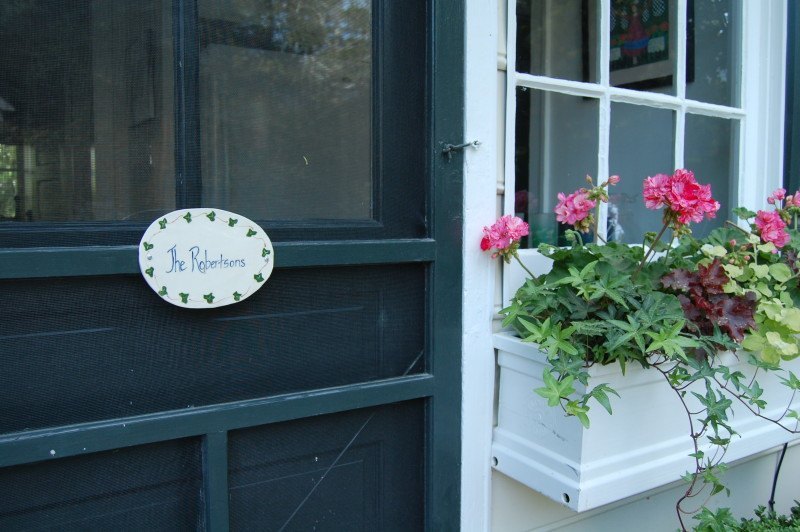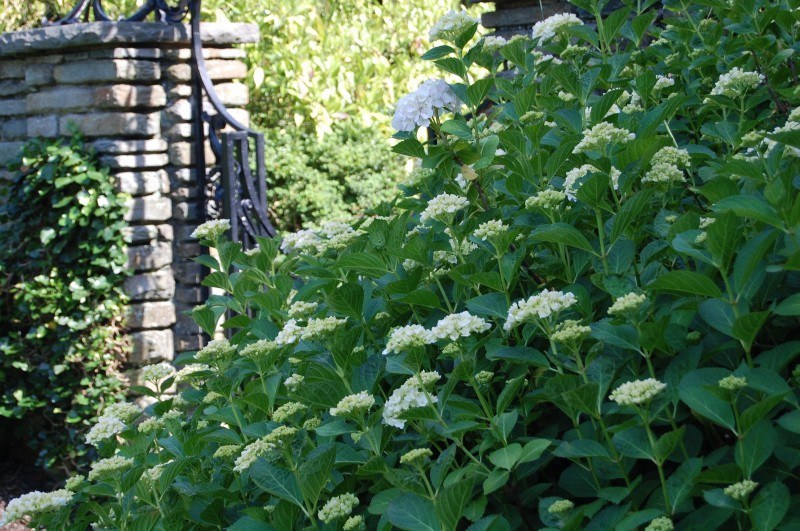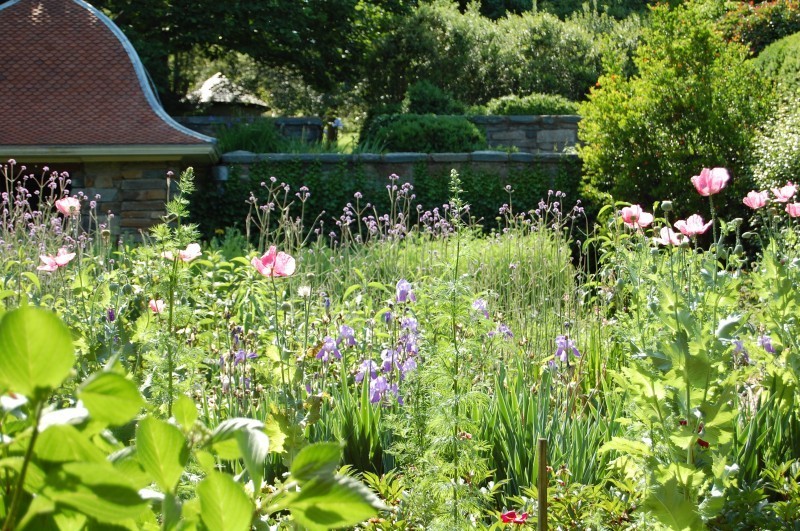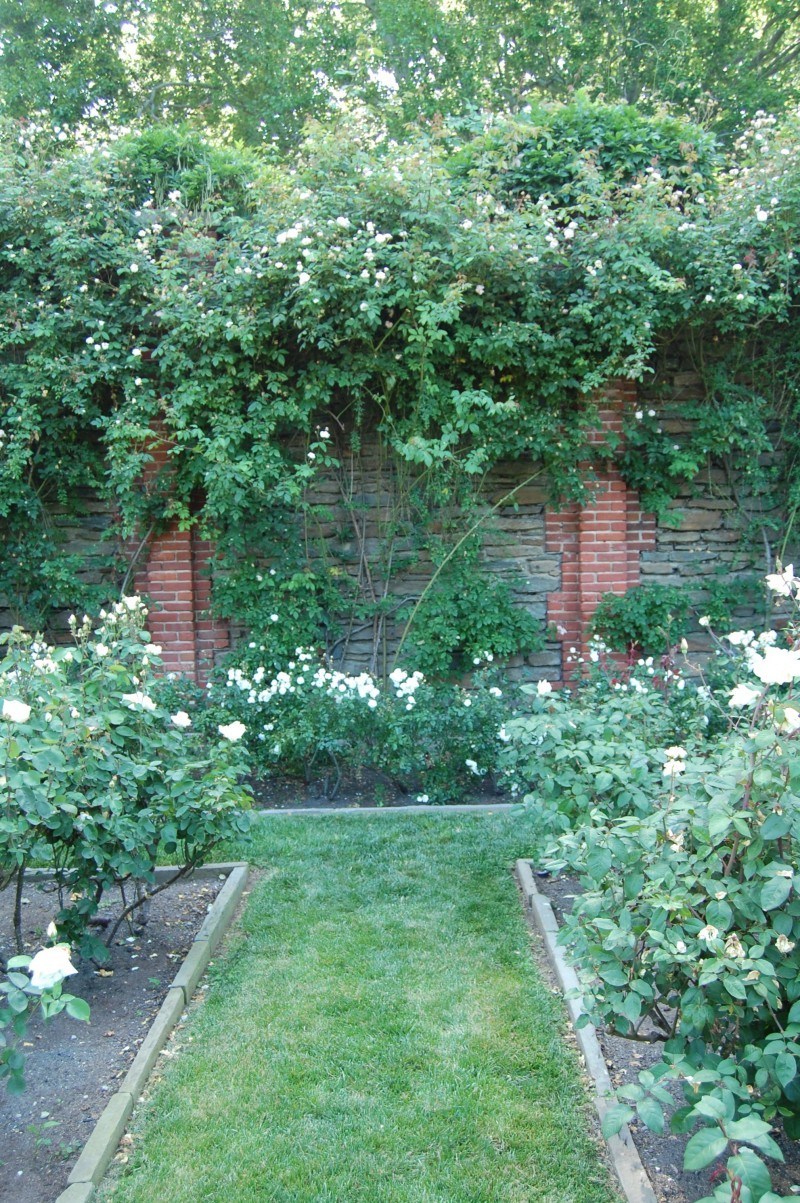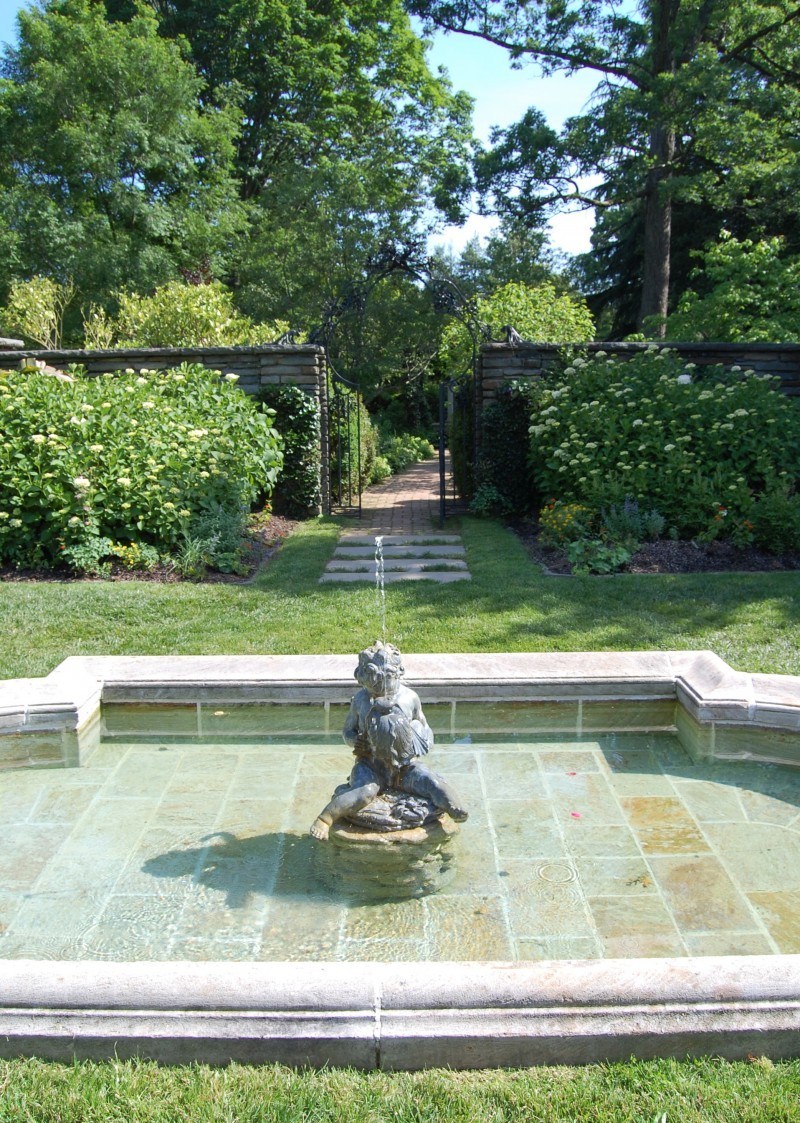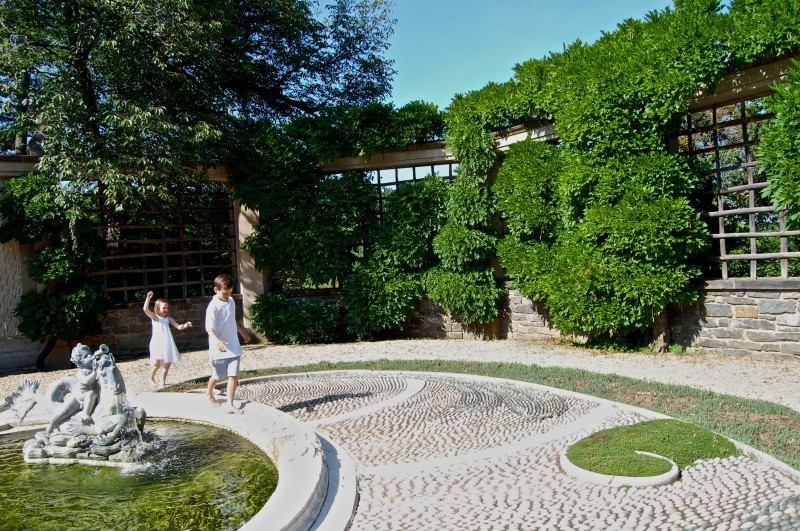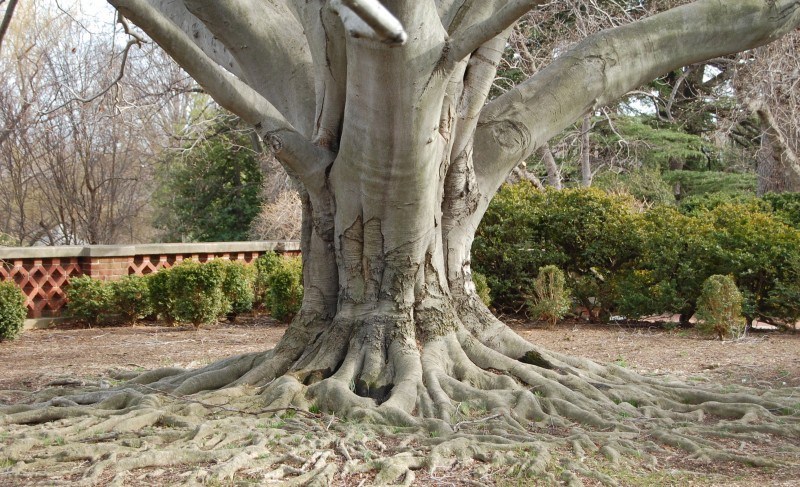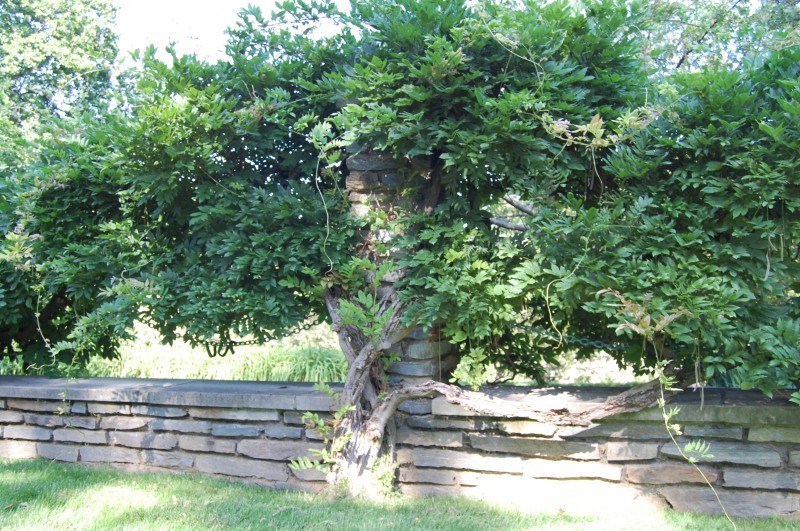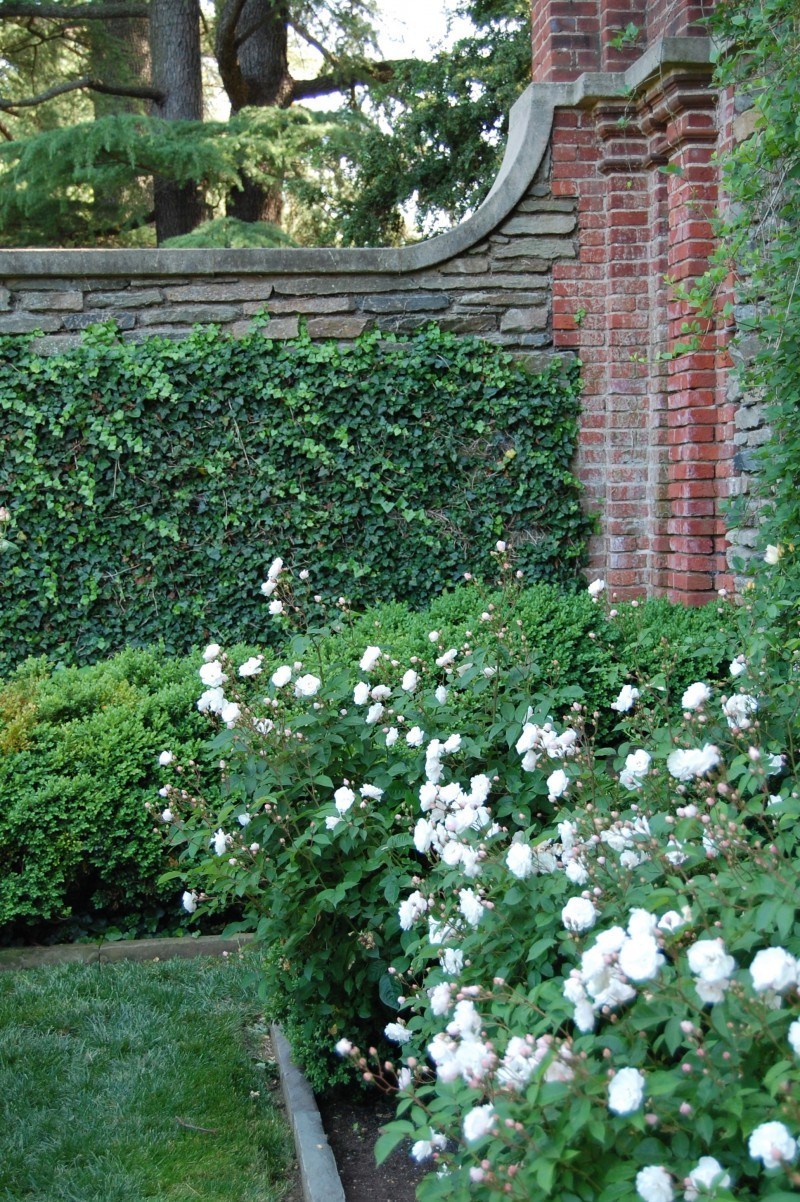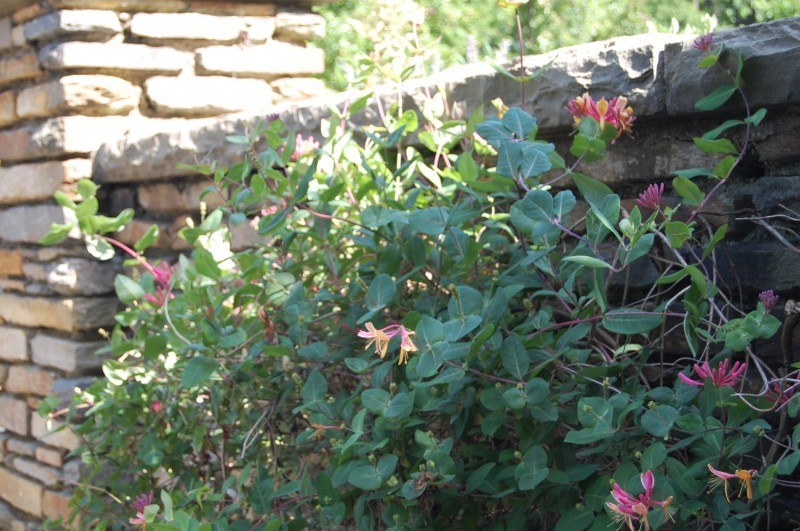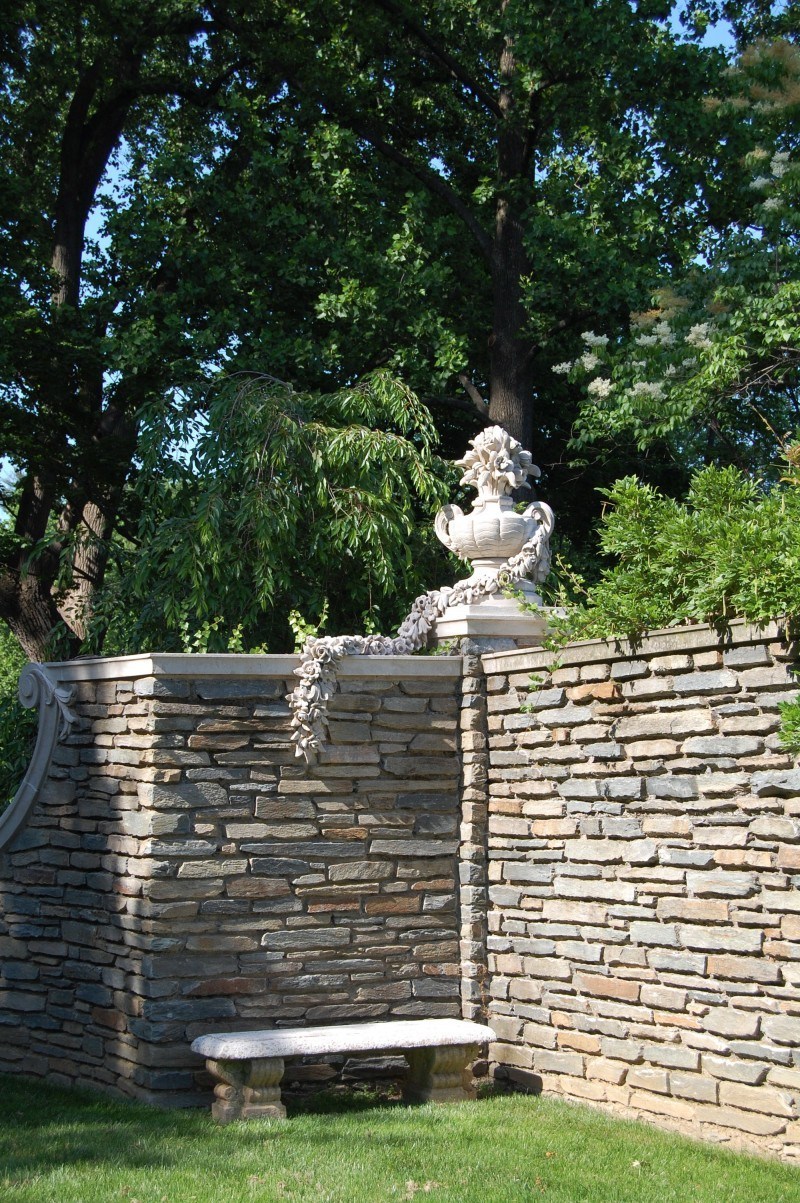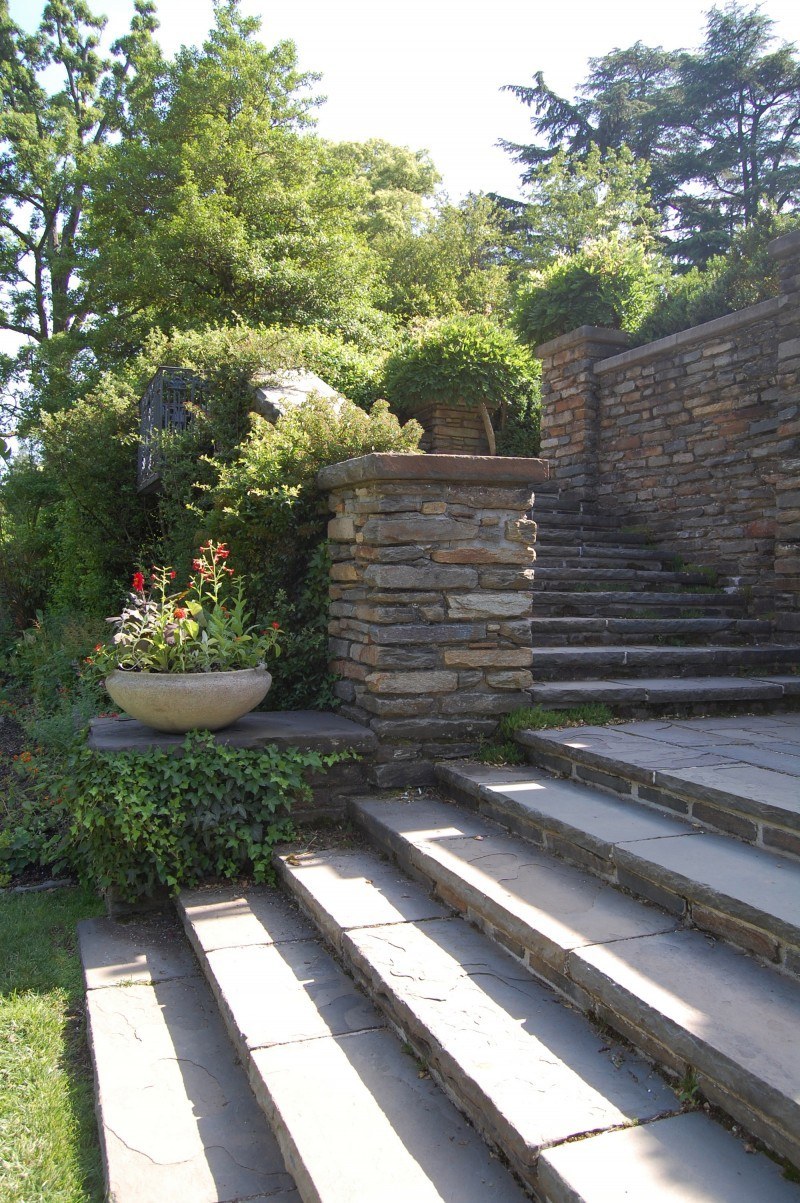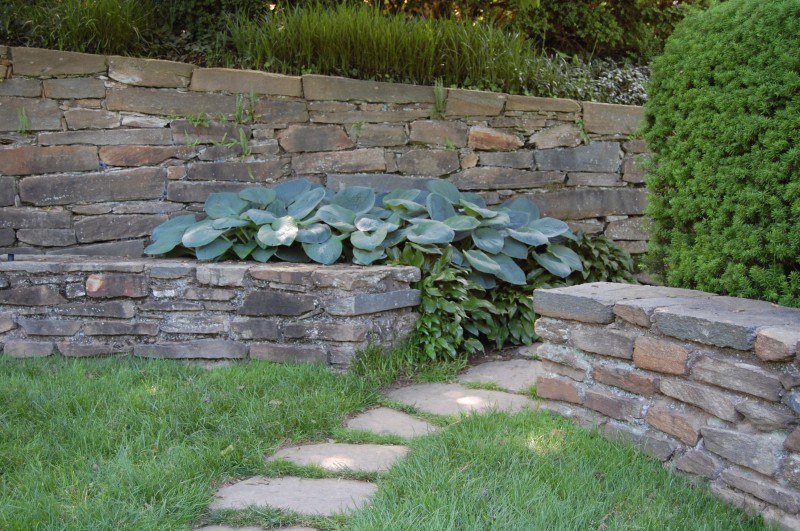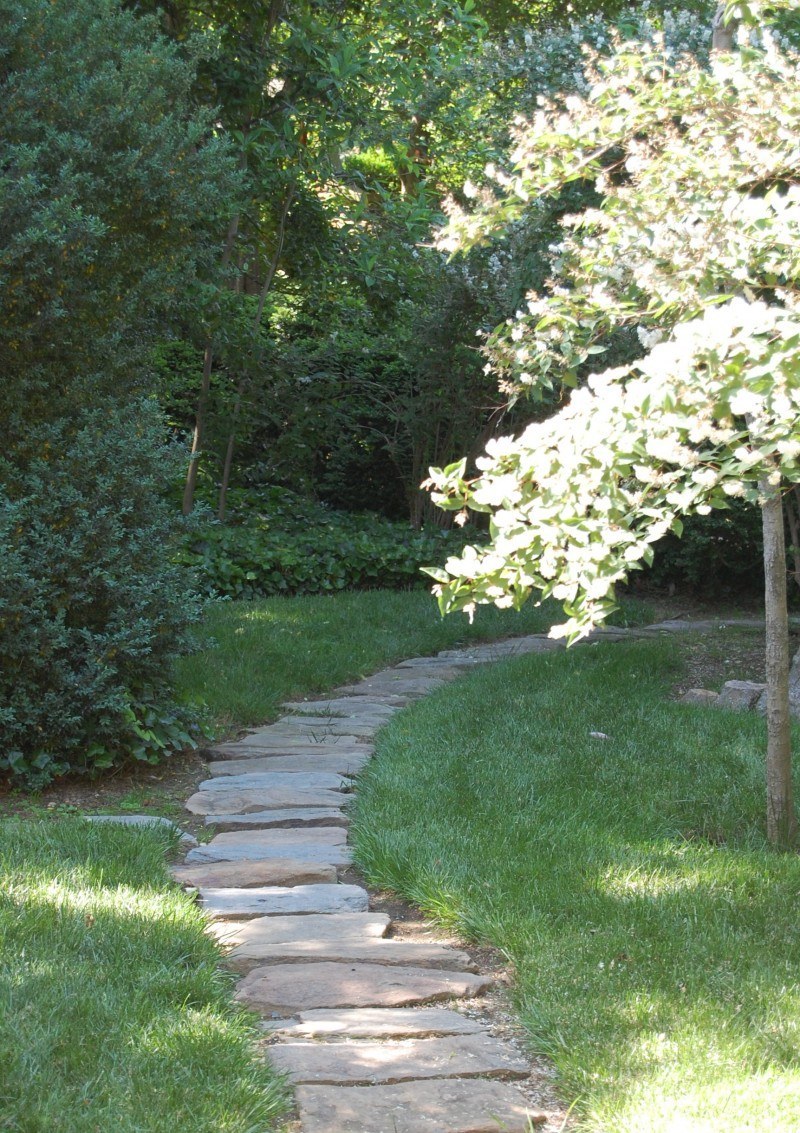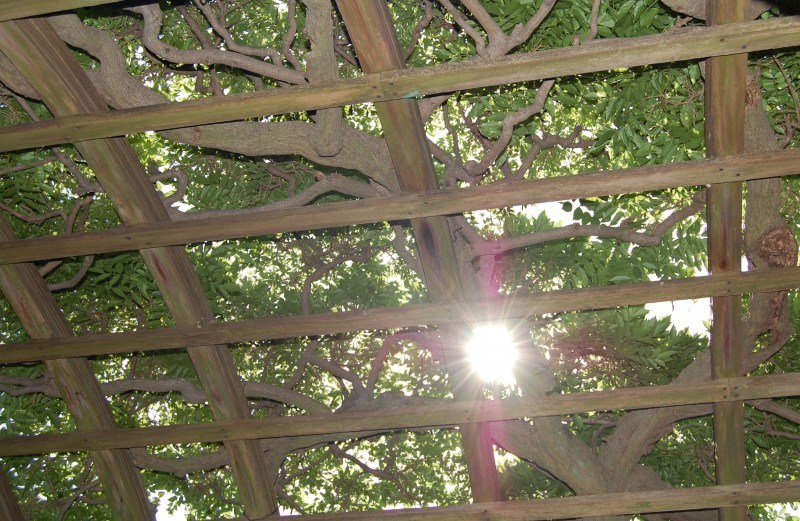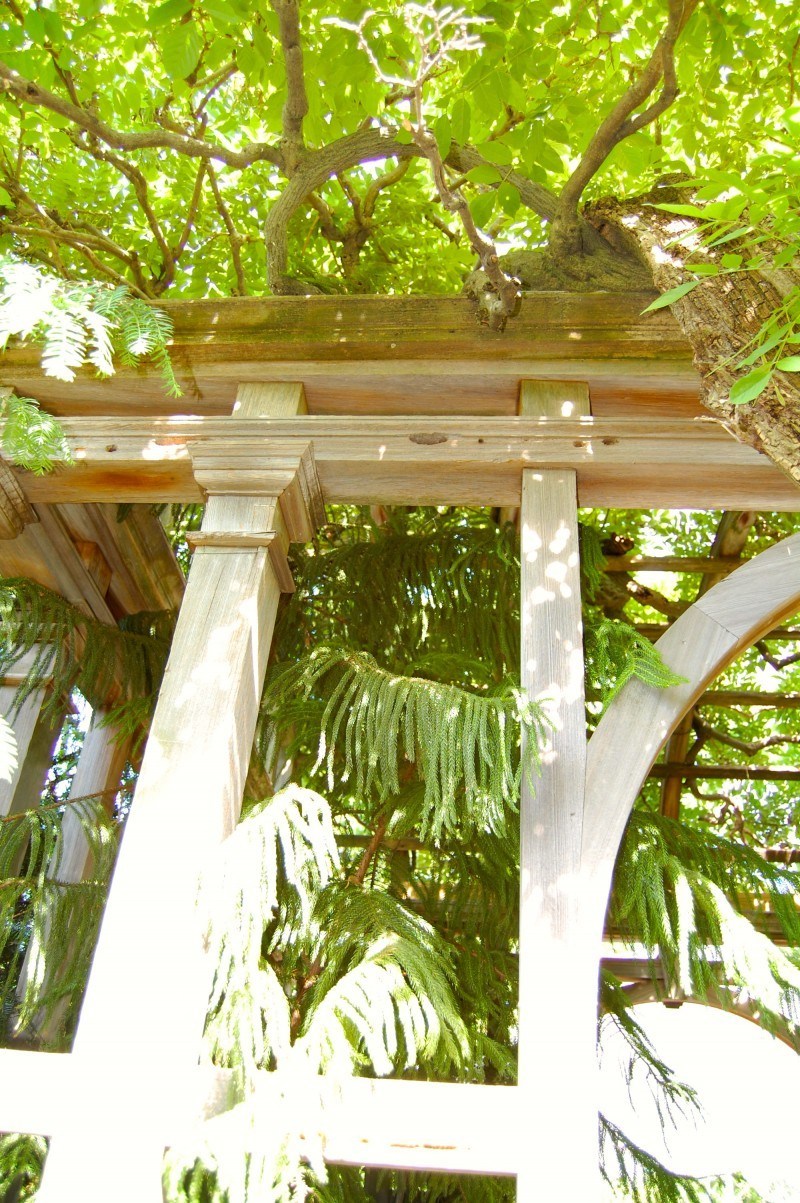THE ARTISTRY OF FLOWERS AND GREENS: HGW 2013
A few weeks ago, I wrote about three gardens on the Historic Garden Week tours in Richmond. The women in the James River Garden Club cut greens and flowers, got very imaginative with containers, rolled up their sleeves, and got to work creating beautiful arrangements from the bounty of their gardens.
Blanche Toms and Dianne Butler are raring to go.
Apricot Tulips and Variegated Solomon’s Seal (Polygonatum variegatum)
A riot of Lenten Rose (Helleborus orientalis)
Snowball Viburnum (Viburnum opulus ‘Roseum’), Lenten Rose (Helleborus orientalis) and White Tulips
Peggy Valentine uses some of her prized Peonies in this arrangement for the dining table of her daughter-in-law, Laura.
Bridalwreath Spirea (Spiraea vanhouttei), Pieris (Pieris japonica), Lilac (Syringa vulgaris), Roses and Herbaceous Peonies (Paeonia lactiflora)
Lenten Rose (Helleborus orientalis) and Variegated Boxwood (Buxus sempervirens ‘Variegata’) float in a bowl
Margaret Reynolds and Susie Rawls work their magic
Betsy Trow is the master of mantlepieces. Here, she has combined Burford Holly (Ilex burfordii), Arborvitae (Thuja), Eucalyptus, Prague Viburnum (Viburnum pragense), Smokebush (Cotinus coggygria), Eleagnus (Eleagnus angustifolia), Horsetail Palm (Equisetum arvense), Carolina Sweetshrub (Calycanthus floridus), Fennel (Foeniculum vulgare) and Lenten Rose (Helleborus orientalis), among other plants.
Claire Williams, Mary Frediani, Kathleen Reid and Liz Talley take advantage of a spring that gave us a bonanza of Viburnum.
Snowball Viburnum (Viburnum opulus ‘Roseum’), Variegated Solomon’s Seal (Polygonatum variegatum) and the other Snowball Viburnum (Viburnum macrocephalum)
Ranunculus, Tulips, Bleeding Heart (Dicentra spectabilis), Bridalwreath Spirea (Spiraea vanhouttei) and Peonies (Paeonia lactiflora), arranged in individual baby cups, julep cups, bottles and bud vases, brighten the bar.
Margaret Valentine is off to work.
A mass of white Lilac (Syringa vulgaris)
A fuzzy fern frond (don’t know which one, daggone it!) and native Columbine (Aquilegia canadensis)
Page Fitchett and her daughter Mary Carpenter take their cues from the colors in daughter/sister Susan Robertson’s dining room.
Coral Honeysuckle (Lonicera sempervirens), Autumn Fern (Dryopteris erythrosora), Ligularia, Kerria (Kerria japonica), Columbine (Aquilegia canadensis), Azalea, Roses and Curly Willow (Salix matsudana ‘Tortuosa’), among other plants
Blue Star (Amsonia tabernaemontana), Yew (Taxus baccata), Snowball Viburnum (Viburnum opulus ‘Roseum’), Variegated Euonymous (Eounymous japonicus) and Bleeding Heart (Dicentra spectabilis) in “Wellies”
HISTORIC GARDEN WEEK: THE ETHERINGTON GARDEN
In celebration of the Garden Club of Virginia’s 80th Historic Garden Week, I’m giving sneak peaks at three special gardens on the Richmond tour. Susan Robertson, Laura Valentine and Moonie Etherington have created gardens that reflect their passions and personalities. The Robertson and Valentine gardens were on the Tuesday tour and the Etherington garden is on tour Thursday.
THE ETHERINGTON GARDEN
Moonie and Bill Etherington’s home sits high above the James River, the grounds gracefully sloping toward an outcropping of rock. Far below is the Philadelphia Quarry, now a private swimming club. Stone mined from the quarry was made into retaining walls that sweep across the lawn and form cozy enclosures overlooking the quarry. Moonie, a naturalist and plantswoman extraordinaire, has embraced this rural oasis in the city, creating gardens filled with native plants, which provide a playground for wildlife and her grandchildren.
Moonie’s garden is all about the plants. Each one has a story, each one is treated like a member of the family. A gentle and generous spirit, Moonie shares her plants with friends and strangers — anyone who she knows will love them as much as she does.
Moonie provides birdbaths, bird houses and plenty of food-bearing plants for her feathered friends. Just outside the kitchen door is a bird house that is as often inhabited by snakes as it is by birds.
The Pieris path, along the cobblestone walkway, was planted in 1984 in memory of Moonie’s mother, who loved Pieris japonica and Gardenia.
Moonie tucked Lewisia into the crevices of the rock. She told me that Lewisia is named for Meriweather Lewis because Lewis and Clark discovered it somewhere in Tennessee or Kentucky on their westward journey.
Here, fern fiddlers unfurl, while Lichen and Moss thrive in the cool shade.
Virginia Bluebells (Mertensia virginica) pop behind various native ferns in the woodland garden outside Moonie’s kitchen window.
The bed next to Moonie’s driveway is filled with gifts from special friends. Above, Bearded Iris have made a home in a rotted out stump. Below, are Margaret Bemiss’s special white violets. Moonie’s vigilance has saved the violets from many well-meaning weeders.
Moonie has a deal with the resident deer. She keeps the deer path clear for them, and they leave her spring-flowering shrubs alone. These include Kerria, Deutzia, Calycanthus, Pieris and Quince.
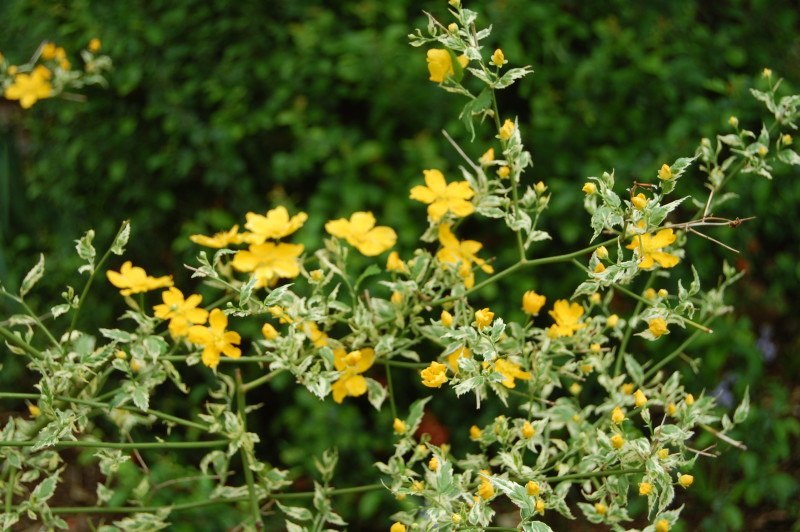 I love this Kerria. It has a single flower and variegated leaves.
I love this Kerria. It has a single flower and variegated leaves.
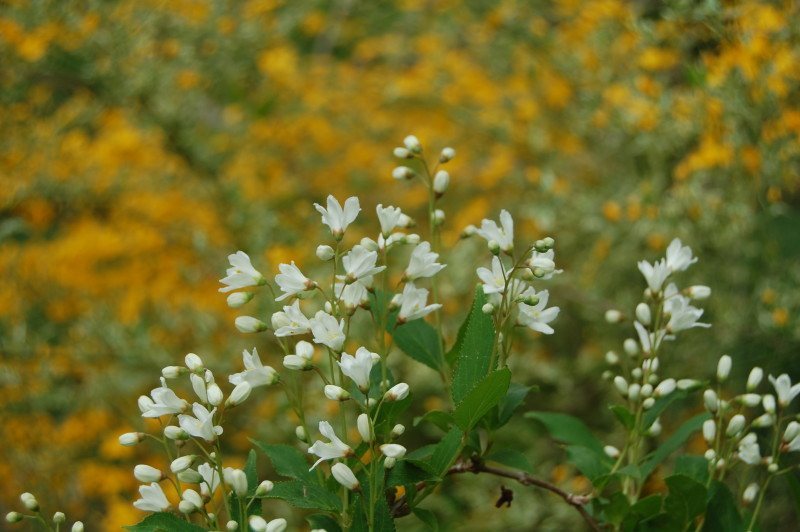 The Kerria looks spectacular next to the Deutzia gracilis.
The Kerria looks spectacular next to the Deutzia gracilis.
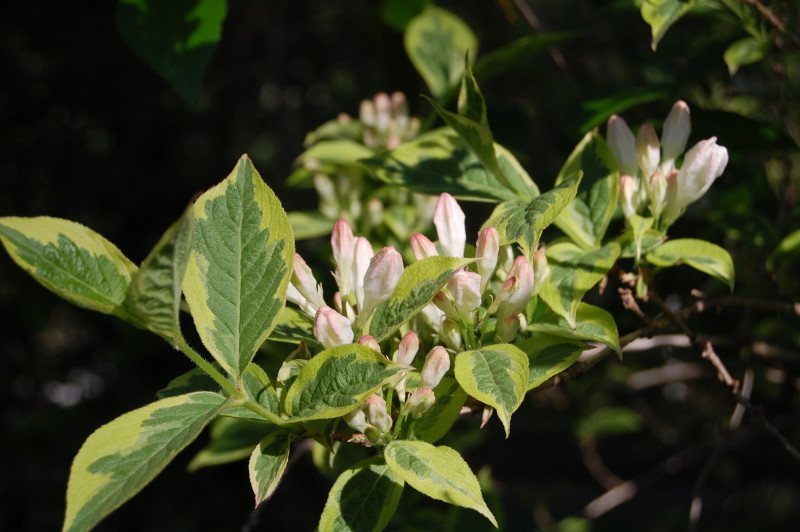 Variegated Weigelia (Weigelia variegatum).
Variegated Weigelia (Weigelia variegatum).
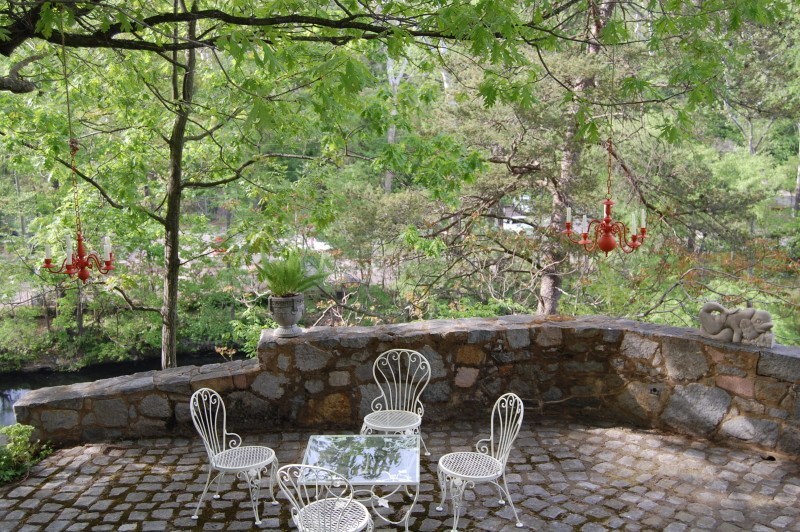 I wonder if the deer have cocktails here when the Etheringtons aren’t looking.
I wonder if the deer have cocktails here when the Etheringtons aren’t looking.
Willie Brown gave Moonie this Moricandia arvensis (Chinese Temple Bells — aka the provocatively named Purple Mistress) when Moonie joined the James River Garden Club. Moonie collects the seeds from this woodland perennial and shares them with friends. She is going to give some to me to plant on Chapel Island. James River Park Manager Nathan Burrell and his team have cleared and built trails on the island and will be planting native woodland plants in a few weeks.
Poet’s Laurel (Danae racemosa) spills over the granite stone steps leading to the house.
Tucked under the shrubs are Trillium (above) and Woodland Poppies from Thomas Jefferson’s Tufton Farm.
Native Columbine (Aquilegia canadensis) has spread under the Dogwood.
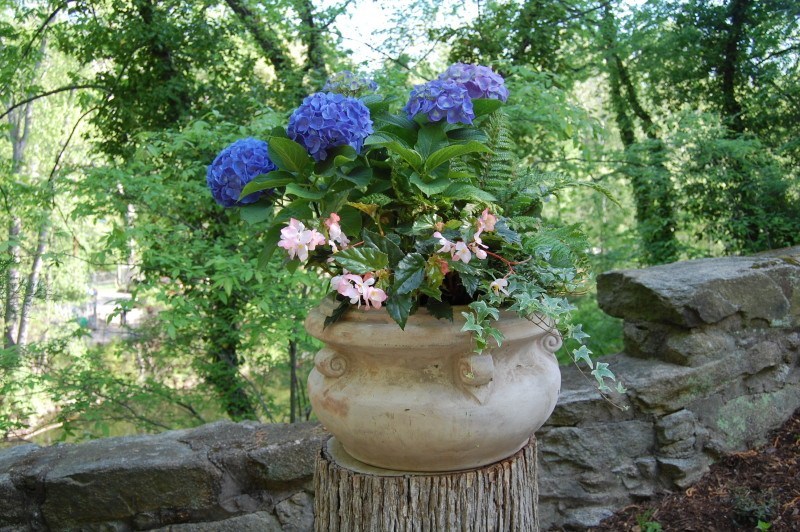 When the Etheringtons lost this tree on the edge of the quarry, they saved some of its wood to make stools for the grandkids, and left the stump in its memory.
When the Etheringtons lost this tree on the edge of the quarry, they saved some of its wood to make stools for the grandkids, and left the stump in its memory.
This stunning Carolina Silverbell (Halesia carolina) was in full bloom last week. As I fretted over whether it would still be in its full glory during the garden tour, Moonie looked fondly at the tree and said, “well, it’s been a joy for me.”
So many women (and men) work countless hours to make Historic Garden Week a success, striving to provide the thousands of visitors a memorable tour of the beautiful houses and gardens. Moonie’s comment brought me back to what Garden Week is all about: celebrating the beauty of this verdant Commonwealth in which we live, and preserving and restoring what brings joy to us every day.
HISTORIC GARDEN WEEK: THE VALENTINE GARDEN
In celebration of the Garden Club of Virginia’s 80th Historic Garden Week, I’m giving a sneak peak of three very special gardens on the Richmond tour by three talented women. Susan Robertson, Laura Valentine and Moonie Etherington have created gardens that reflect their passions and personalities. The Robertson and Valentine gardens are on the Tuesday tour and the Etherington garden is on the Thursday tour. Today, we visit the garden of Laura and Ned Valentine.
THE VALENTINE GARDEN
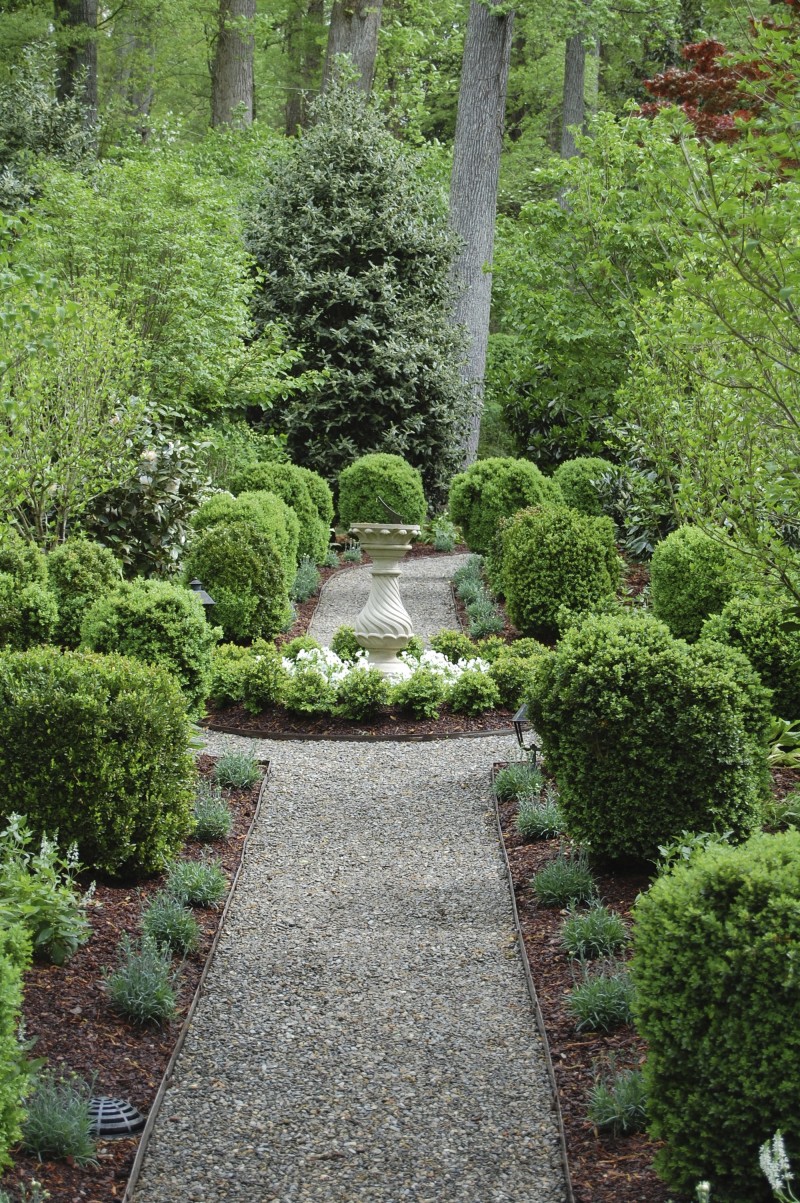
Laura’s sophisticated garden style has its roots in North Carolina. Growing up in Raleigh, some of her earliest memories are of her mother’s and grandmother’s gardens. Legendary southern garden writer Elizabeth Lawrence lived around the corner from Laura’s grandmother in Charlotte. When in Charlotte to see her grandmother, they would often visit Elizabeth Lawrence’s garden. While her mother and grandmother sipped brandy with Miss Lawrence, Laura and her sister wandered the garden, fascinated by the lily pads in her pond and the birds flying through the house.
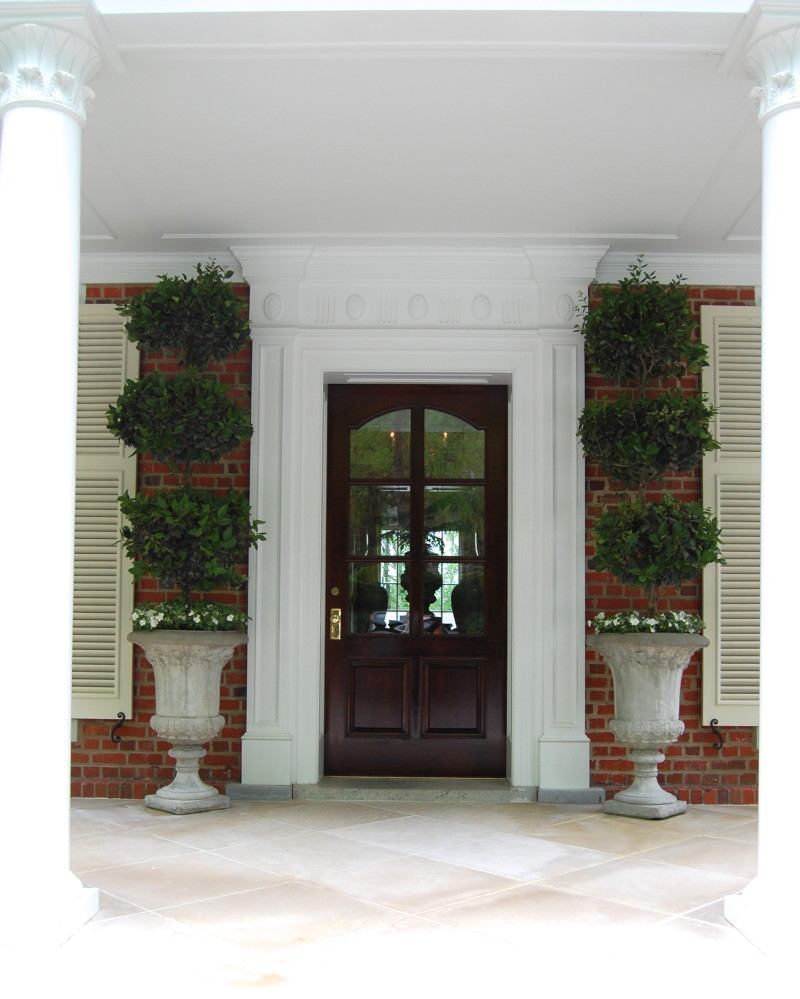
Laura’s husband, Ned, was equally blessed, growing up with a mother who created, and tends, one of the most beautiful gardens in Richmond. Enter North Carolina landscape architect Chip Callaway, who had collaborated with Laura’s family in the past (I’m a huge fan). Laura brought Chip to Richmond to help her with the Valentines’ new garden. Chip appears to have masterfully harnessed these horticultural bloodlines, by creating, with Laura and Ned, a garden that any Tarheel or Wahoo would love.
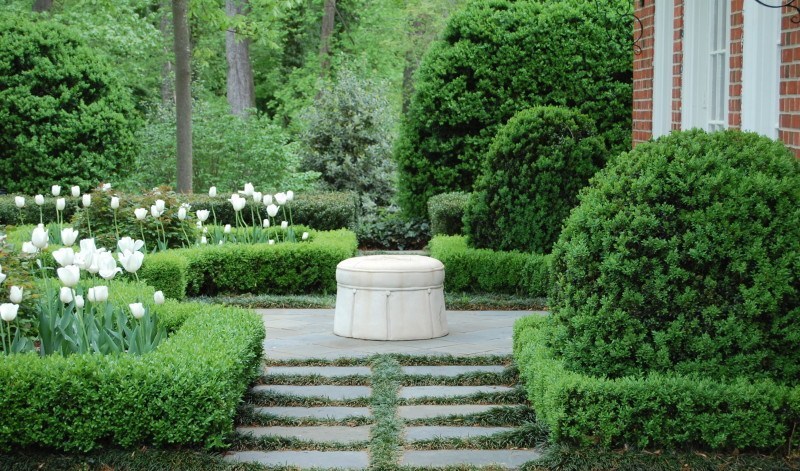
Laura’s love of symmetry and restrained use of color are evident in the twin bluestone terraces that flank the main brick terrace.
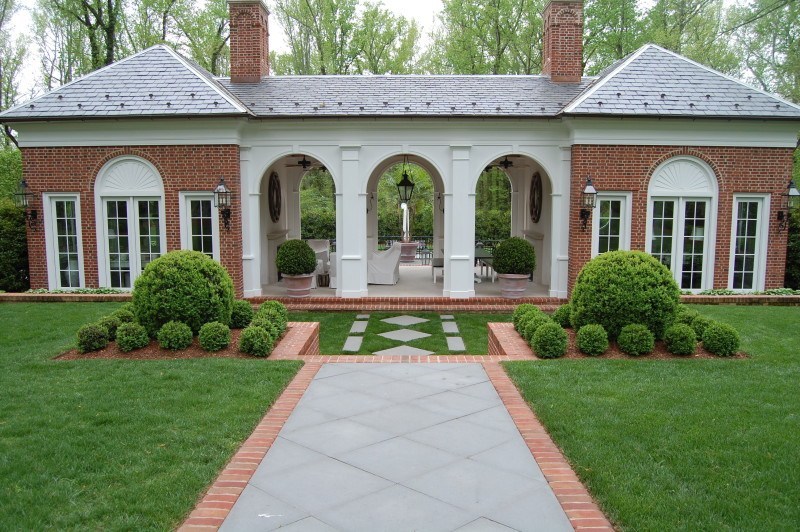
The gardens are reminiscent of Italian Renaissance gardens — the gently sloping property has been transformed into several terraced planes.
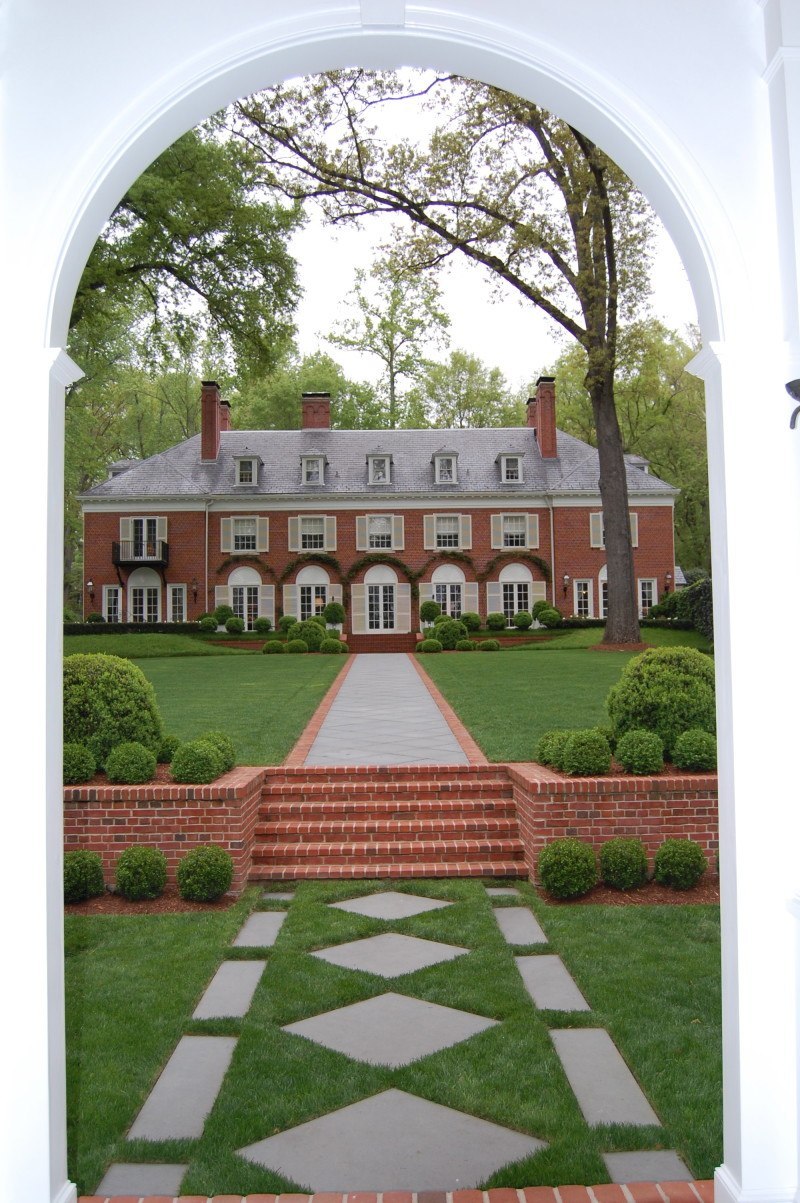
Smilax, an evergreen vine popular in North Carolina, is trained in arches on the back of the house. A farmer near Wilson, North Carolina gave my husband’s cousin the Smilax that climbs our house.
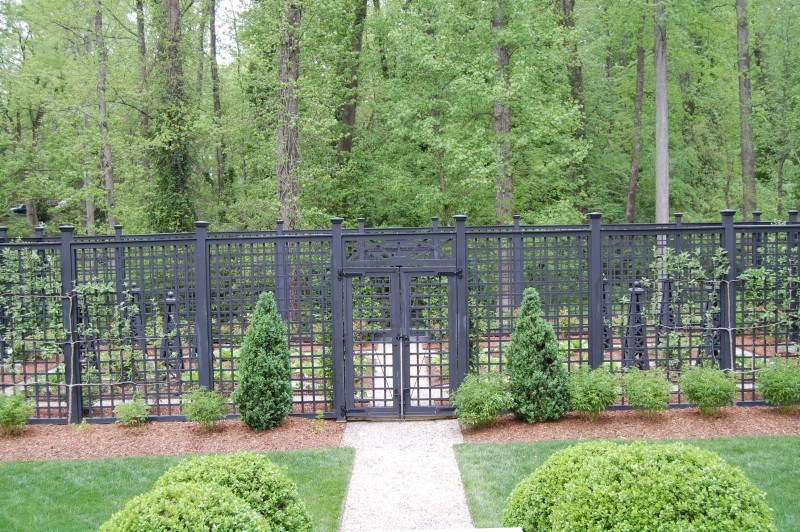
Deer run rampant in this neighborhood bordering the James River. The trellised fence allows the Valentines to grow vegetables and roses and to espallier fruit trees. Derrick, who helps Laura maintain the grounds, has added netting to keep Peter Rabbit and his progeny away.
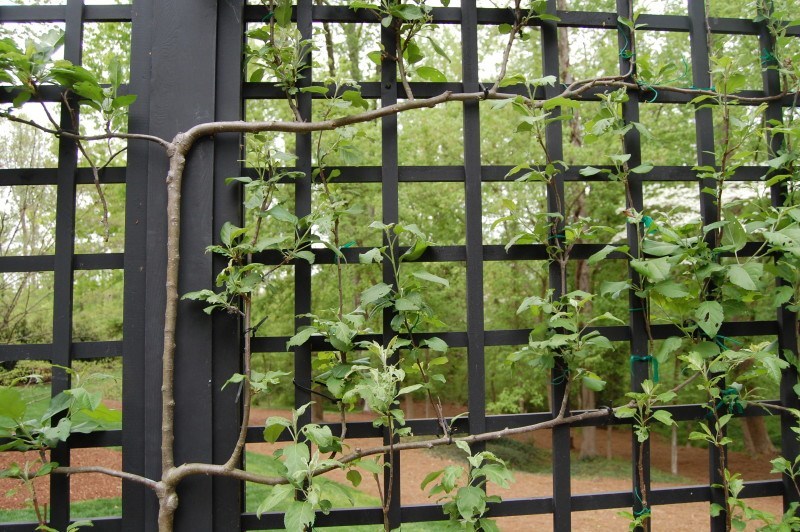
Apple trees are expertly espaliered on the fence.
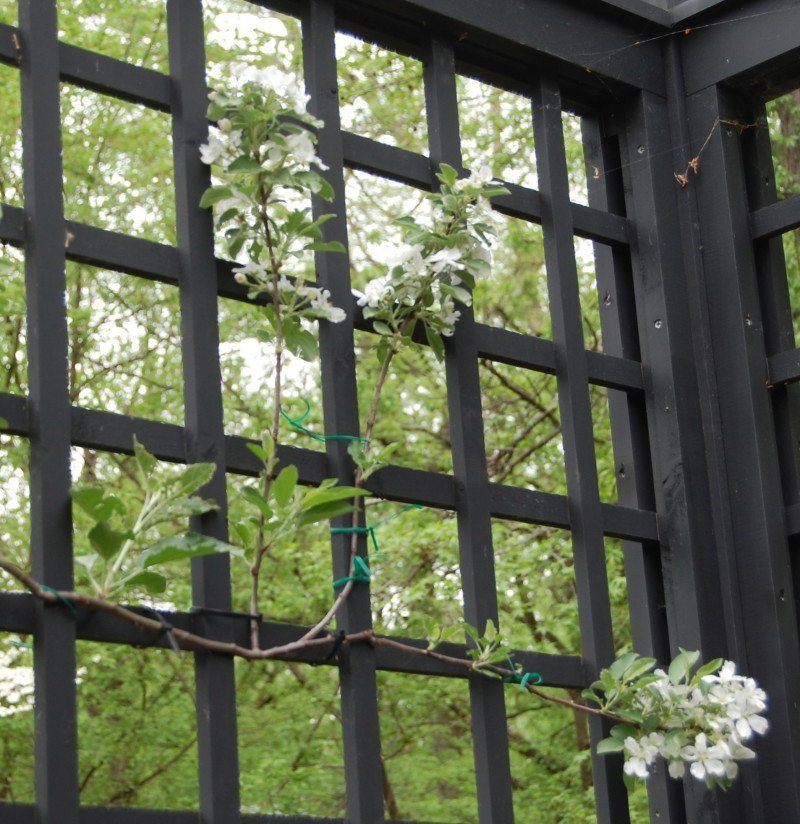 Apple blossoms.
Apple blossoms.
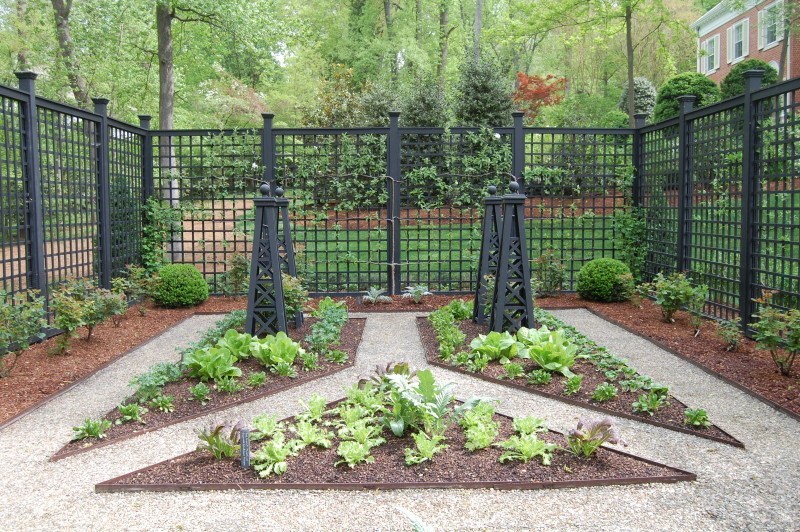
The garden currently is planted with cool season vegetables, including Chinese Cabbages, Chard, Kale, Spinach, Arugula, Escarole and Mustard. The garden is bordered on the inside with roses and the outside with peonies. While the peonies are all white, Laura got jiggy and introduced color with the roses.
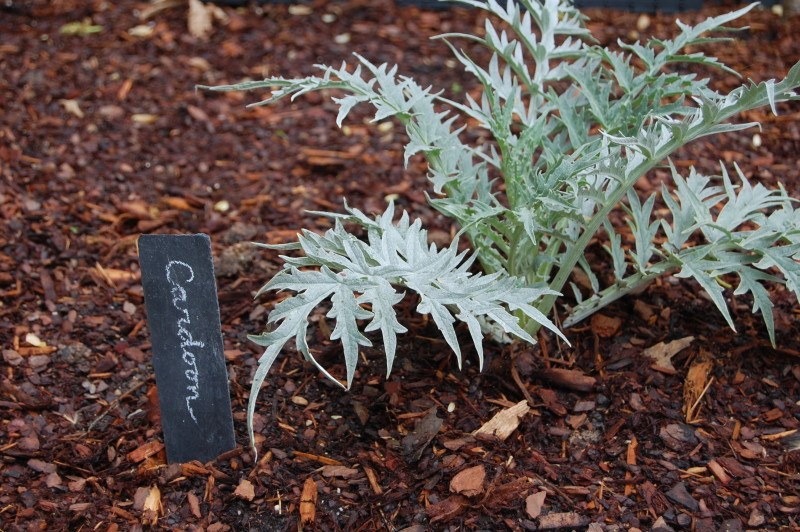 I love the plant markers — written with chalk on pieces of slate. So practical and good looking.
I love the plant markers — written with chalk on pieces of slate. So practical and good looking.
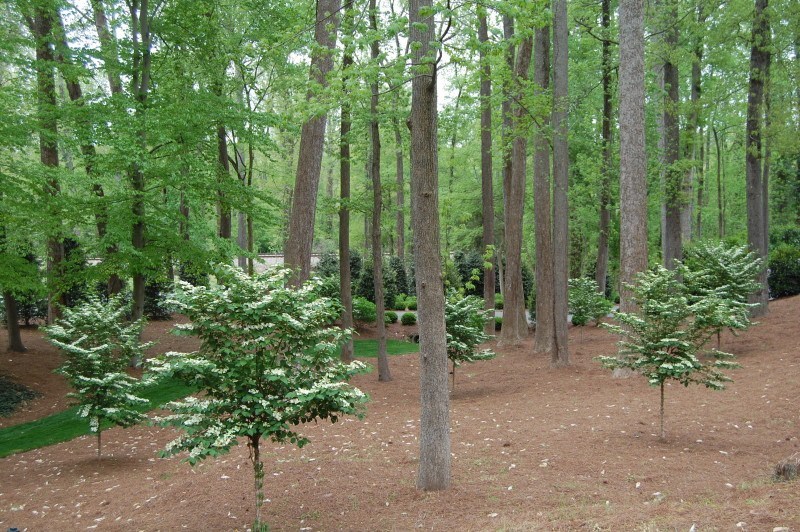
This is a grove of Doublefile Viburnum (Viburnum plicatum var. tomentosum). I have never seen them trained as single-trunk trees — gorgeous!
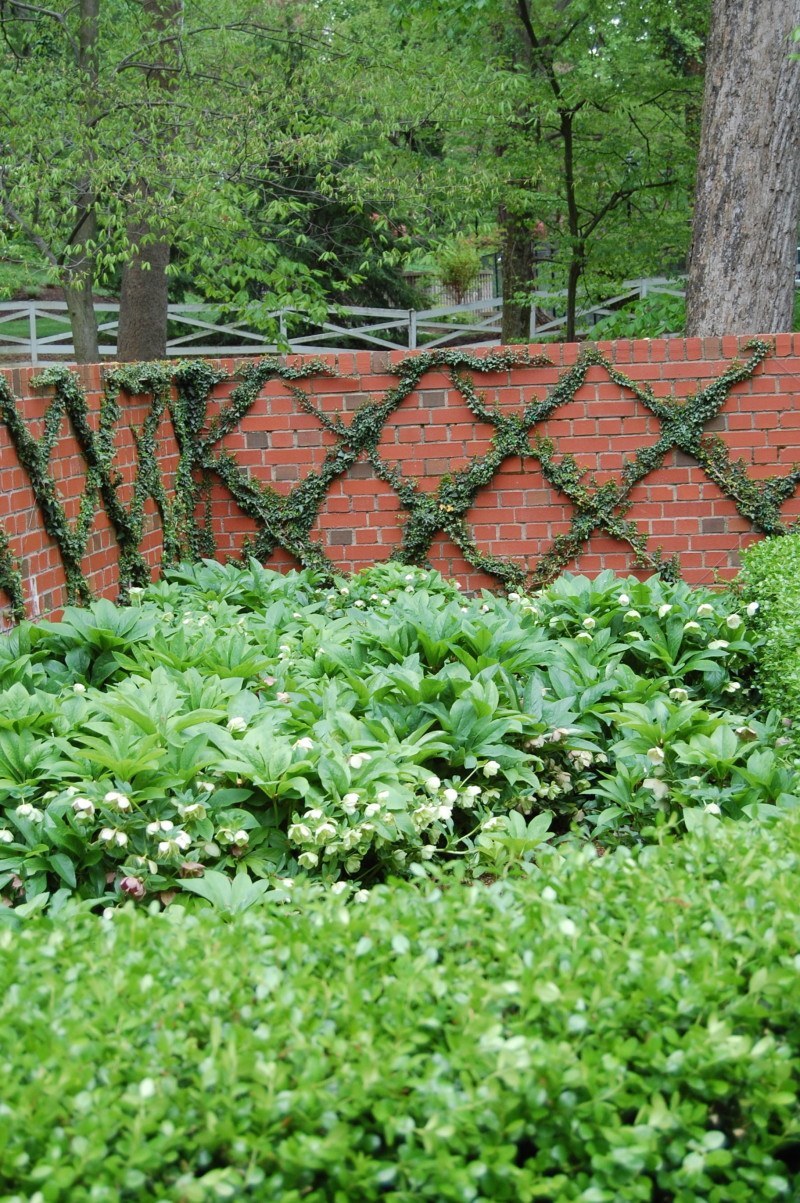
Attention to detail extends even to the service entrance. The Ivy lattice wall is underplanted with Lenten Rose (Helleborus orientalis) and bordered in clipped Boxwood. Laura’s grandmother planted Hellebores long before they hit the mainstream.
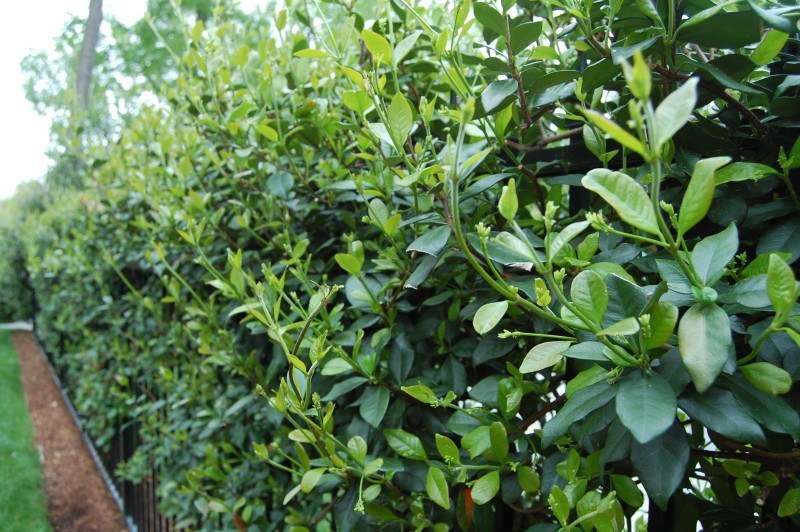
Chip and Laura make the most of veritcal opportunities. Here, Confederate Jasmine, about to bloom, blankets the pool fence.
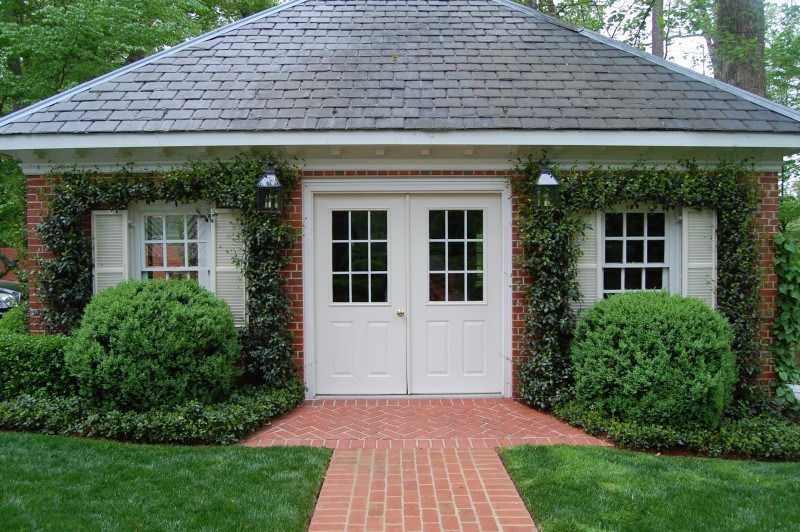
Confederate Jasmine also frames the windows on the garage.
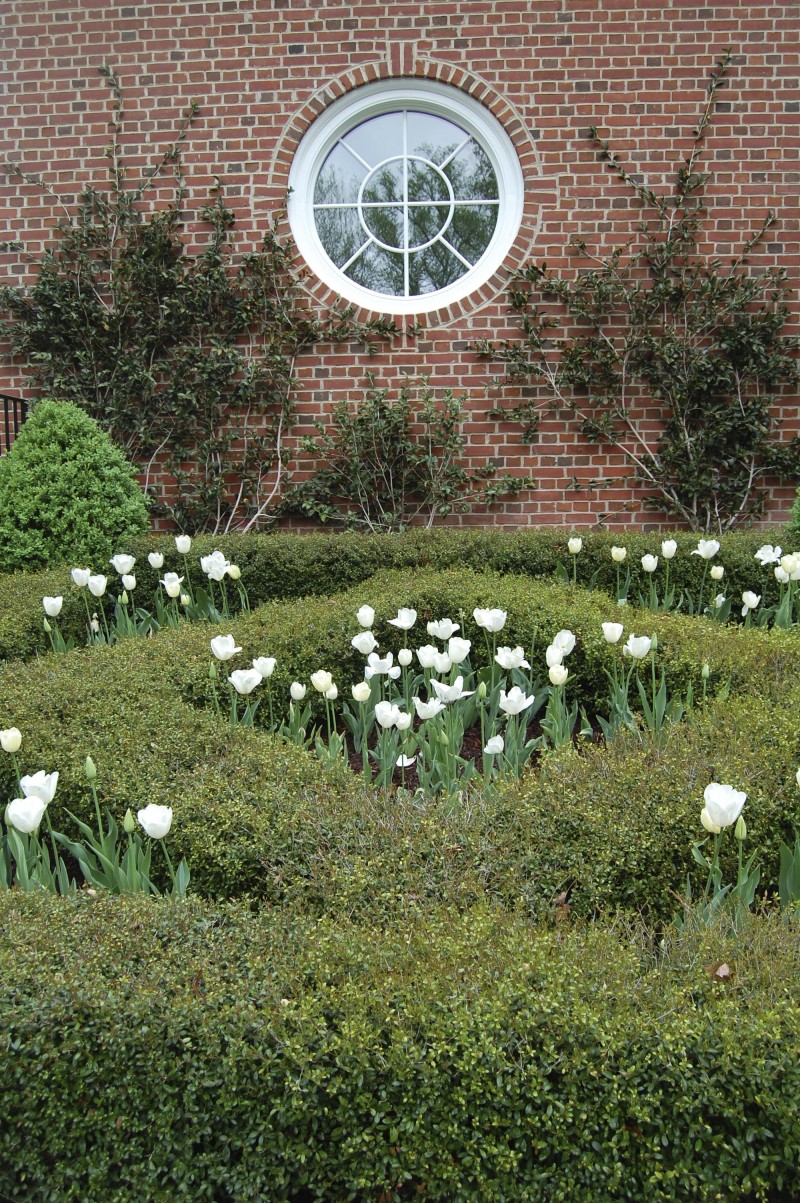
Camellia sasanqua are espaliered on the pool house wall, above, and in the entrance drive, below.
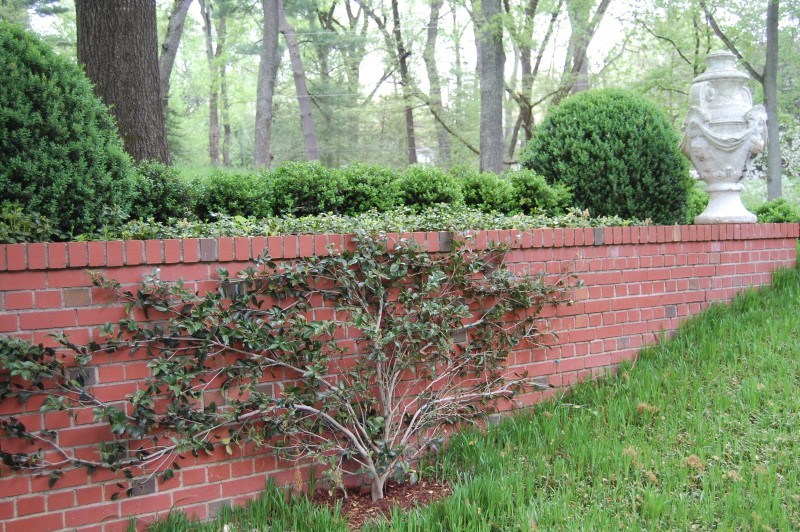
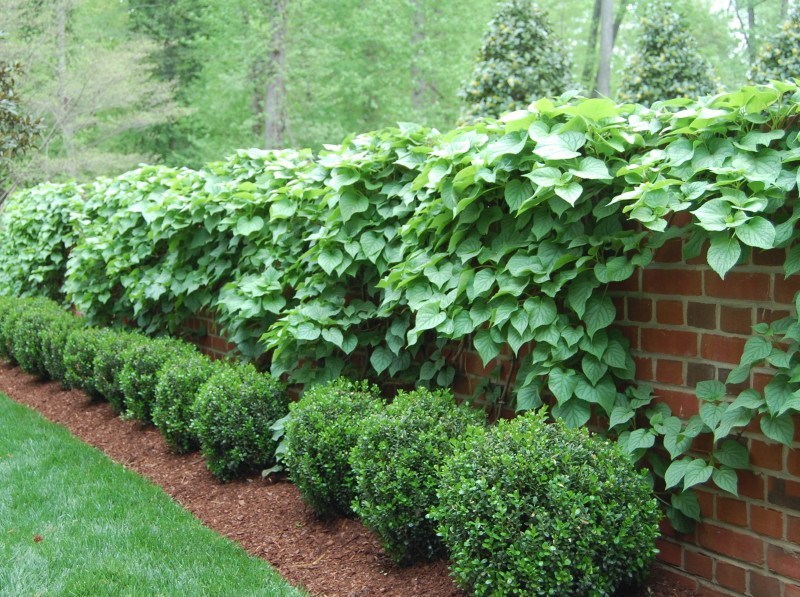
And one last beautiful example of vertical planting: Climbing Hydrangea (Hydrangea anomala subs. petiolaris) softens the wall above the pool house.
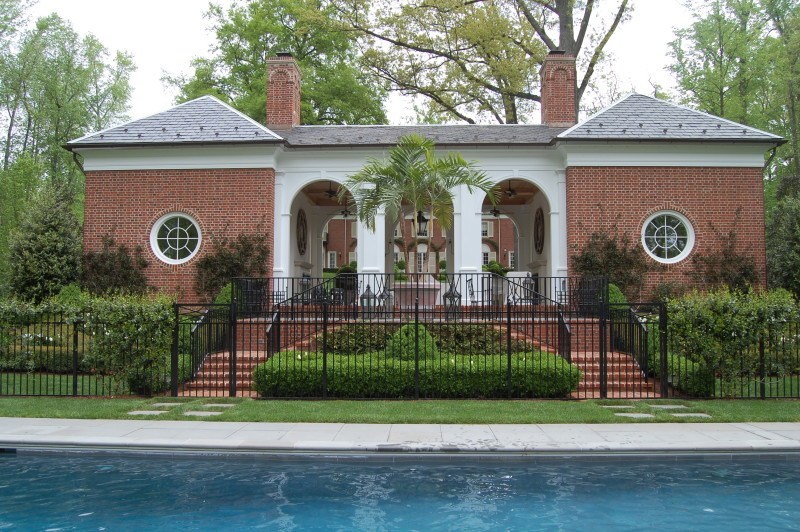
The pool, bordered by a spectacular Chindo Viburnum hedge (not pictured), is at the terminus of the property’s central axis.
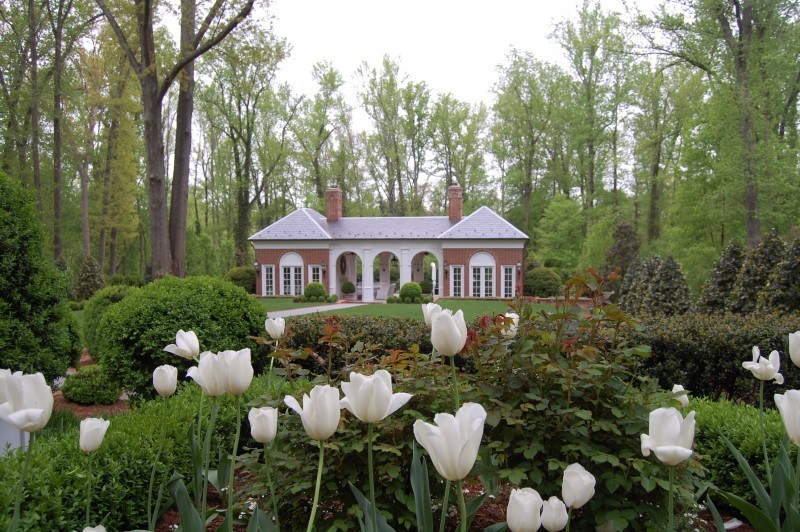
Carter Skinner designed the stunning pool house.
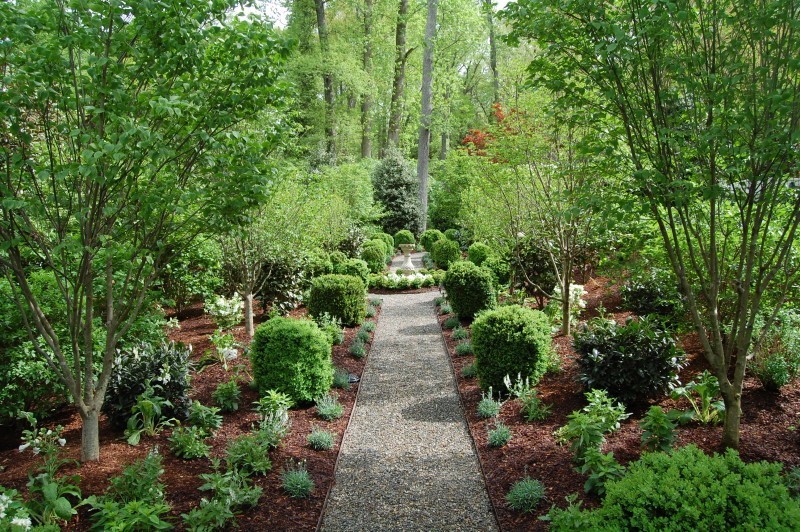
The White Garden contains a central crushed stone path, with a sundial at its center. All of the flowering plants are white. An evergreen backbone of Camellia, Laurel, Boxwood, Chindo Viburnum and Holly is underplanted with Foxglove, Ferns, Variegated Solomon’s Seal, Dianthus and Bleeding Heart. Deciduous shrubs, including Doublefile Viburnum, Snowball Viburnum, Spirea, Pearl Bush, dwarf Butterfly Bush and Limelight Hydrangea are planted symmetrically and rhythmically along the path. Amazingly full-branched Hibiscus circle the sundial, and Dogwoods line the path.

Foxgloves bloom, while Autumn fern fronds unfurl, in the White Garden.
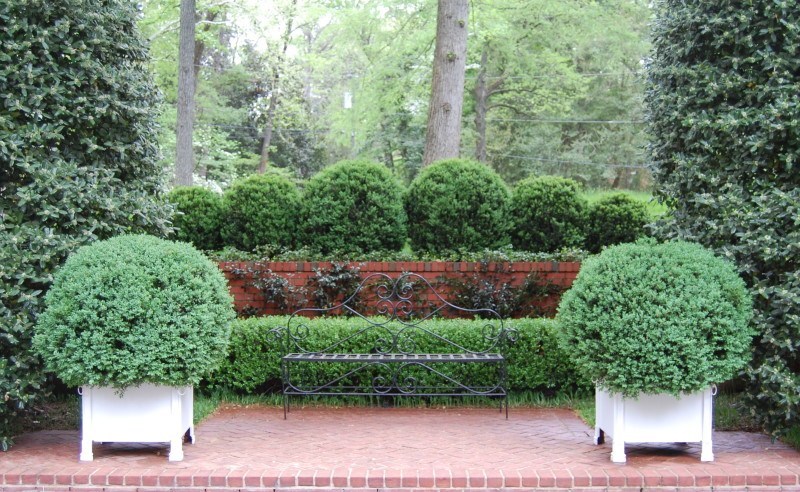
This terrace across the entrance drive from the front door exemplifies the Italianesque aesthetic that Laura loves, and that she and Chip perfected in the Valentines’ garden: consistent use of just a few elements throughout the property, such as the wrought iron bench and the Versaille planters overflowing with lush Boxwood; a strong evergreen backbone of sturdy Hollies, clipped Boxwood and espaliered Camellias; and the use of rich natural materials in beautifully laid — and oft repeated — patterns, such as the brick terrace here.
Alan Greenspan once warned us of irrational exuberance. Laura, Ned and Chip mastered rational exuberance, by allowing structure, form, texture and rich materials to take center stage in a brilliantly designed, and flawlessly executed and maintained landscape. Who says Tarheels and Cavaliers don’t mix?
HISTORIC GARDEN WEEK: THE ROBERTSON GARDEN
In celebration of the Garden Club of Virginia’s 80th Historic Garden Week, I’m giving a sneak peak of three very special gardens on the Richmond tour by three talented women. Susan Robertson, Laura Valentine and Moonie Etherington have created gardens that reflect their passions and personalities. This first blog post focuses on the the Robertsons’ garden. Tomorrow I will post a blog on the Valentines’ garden and Wednesday I will document the Etheringtons’ garden. The Robertson and Valentine gardens are on the Tuesday tour and the Etherington garden is on the Thursday tour.
THE ROBERTSON GARDEN
Susan and Walter Robertson’s beautiful spot of earth is nestled in the woodland that sits just above the historic Kanawha Canal. Susan loves nothing more than digging in her garden — weeding, planting, pruning — it really doesn’t matter, as long as she is surrounded by the plants she has nurtured and nourished over the years. Her yard is her laboratory, whether experimenting with different plant combinations or trying new pruning techniques. She’s generous with sharing her vast knowledge and the bounty of her garden. Susan’s mom, Page Fitchett, instilled in Susan and her sister Mary a love of gardening. Mary and Page will be in town to help arrange flowers in Susan’s house this week.
Akebia (Akebia quinata), a native vine, scampers up the front porch posts. A Passion Flower vine is growing in the urn.
A Robin takes a bath in the shade garden.
The pool used to be separated from the house by a fence. Susan and Walter reconfigured the space, moving the fence to the perimeter and adding broad steps leading directly to the pool.
The pool house has been a relaxing refuge for many friends and family (to my knowledge, George Washington did not sleep here).
The back porch of the pool house overlooks the backyard sloping toward the canal.
Stormwater drains from the terrace through the weep holes in the wall, then filters through the river rock and is absorbed by the water-loving hydrangeas. Capturing the storm water in the garden has the double benefit of channeling it toward plants who need it and preventing it from entering the river through drains.
Perennials and hydrangea will be blooming in the next few weeks in the pool garden.
It is so hard to find this classic pale lavender shade of Bearded Iris (Iris germanica) in the nurseries. I can’t promise I won’t come dig this up someday when nobody’s around.
Susan planted an herb garden just outside her kitchen. She uses crushed stone as a mulch to help keep the weeds at bay (the stones also make it easier to remove the weeds).
Coral Honeysuckle (Lonicera sempervirens) twines around the tuteur.
Nuff said.
No, this isn’t the 14th hole at Augusta — but hey, wouldn’t that be an entertaining challenge!
Lady Banks Rose (Rosa banksiae) floats above the Eastern Bluestar (Amsonia tabernaemontana, better known simply as Amsonia).
This is where Walter goes to be alone with his thoughts after the Nationals spank the Braves.
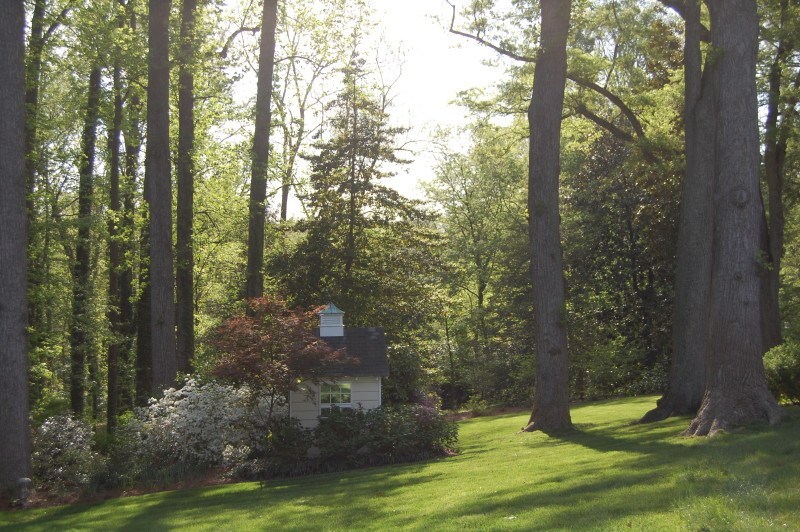 The sun casts long shadows across the sloping lawn.
The sun casts long shadows across the sloping lawn.
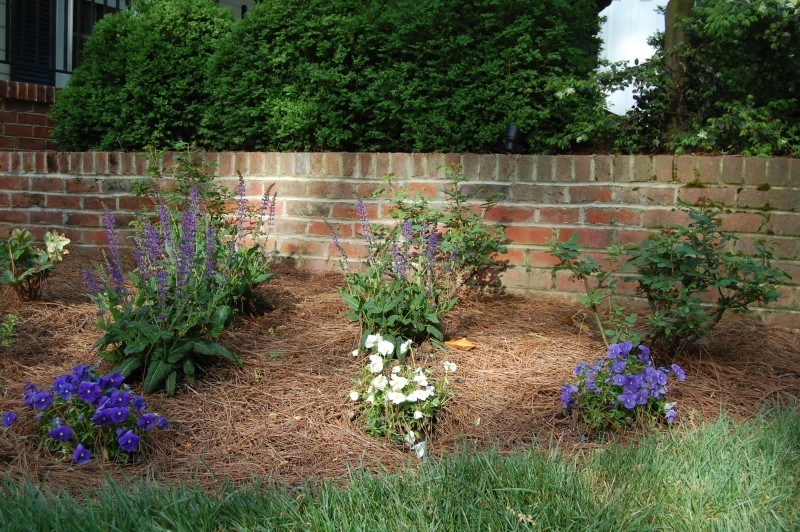 The deer love the Robertsons’ yard. Most of the plants in their garden are deer resistant, but Susan can’t help planting a few beloved plants that are tasty to the deer. She is my go-to girl on the latest deer deterrents. She’s tried them all.
The deer love the Robertsons’ yard. Most of the plants in their garden are deer resistant, but Susan can’t help planting a few beloved plants that are tasty to the deer. She is my go-to girl on the latest deer deterrents. She’s tried them all.
No crape murder in this yard.
The white Azaleas and the Doublefile Viburnum (Viburnum plicatum var. tomentosum) are both at their peak right now.
THE GARDENS OF DUMBARTON OAKS
Tucked away in a quiet part of Georgetown is Dumbarton Oaks, one of the finest American gardens still in existence. Inspired by her travels in Italy with her aunt Edith Wharton (author of Italian Villas and their Gardens), landscape gardener Beatrix Farrand created an American interpretation of the classical Mediterranean gardens she had studied, by carving out a series of garden rooms from the hilly terrain near Rock Creek for Mildred and Robert Woods Bliss, beginning in 1921.
Farrand designed a series of stone and brick walls, paths and steps, as well as arbors, trellises, pools and fountains. Although the layout was guided by Italian principles, she was influenced in her planting design by the English garden style, and Gertrude Jekyll, specifically.
Eleanor McPeck wrote in Beatrix Farrand’s American Landscapes, that Farrand’s trademarks were “clarity of outline, a strong sense of enclosure, the simple plan enriched by architectural detail and softened by perennial beds and trees.” The gardens of Dumbarton Oaks illustrate these principles beautifully.
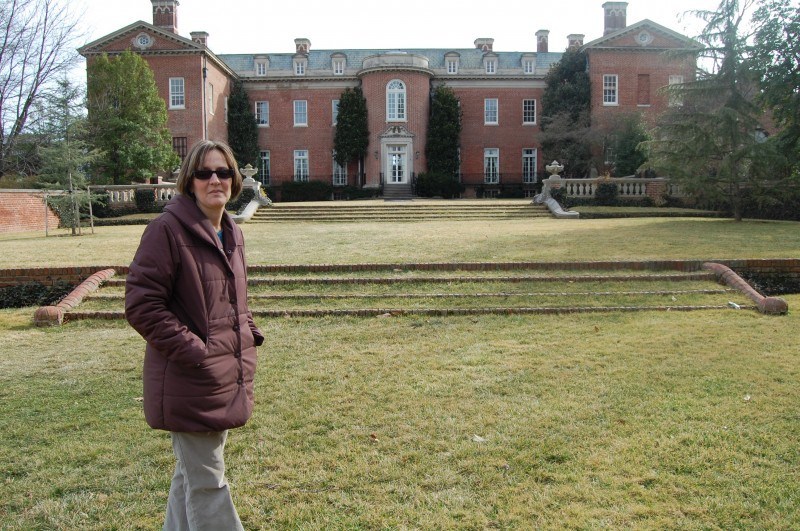
My friend, Carolyn, standing in front of the north facade, below the French steps, on a cold day in February.
In 1941, after the estate was given to Harvard University, director John Thacher asked Farrand to write a guide for the garden’s care. Diane Kostial McGuire, in a foreward to Farrand’s Plant Book for Dumbarton Oaks, wrote that the book “resulted in this unique document that describes measures to be taken when plants need replacement, the various levels of maintenance required, the design concept of each part of the gardens, why particular choices were made, and why certain ideas were rejected.”
Below, a look at the gardens, as described by Beatrix Farrand in her Plant Book:
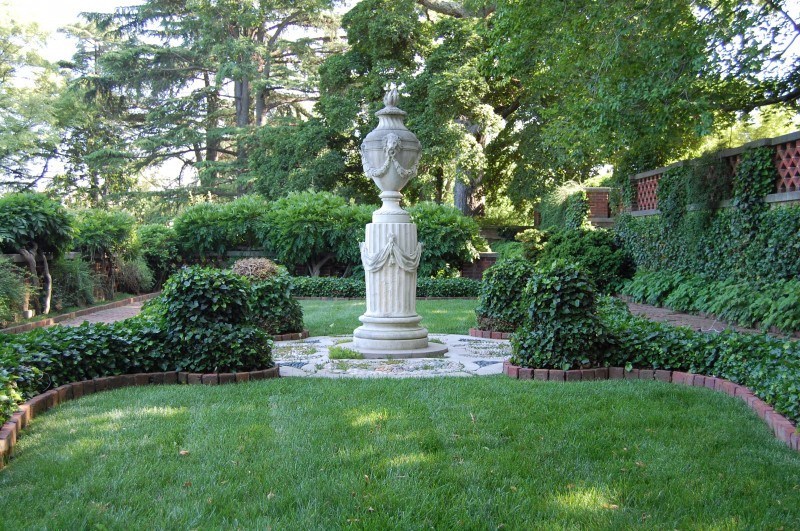
The Box Terrace (a revision by Ruth Havey eliminated the beautiful simplicity of the garden as envisioned by Farrand).
“The Box Terrace is intended to be an introductino to the Rose Garden, rather than a garden of importance on its own account. . . If the Box is allowed to grow too large it engulfs the scale of the terrace, which then tends to look more like a shelf than an overture to the Rose Garden.”
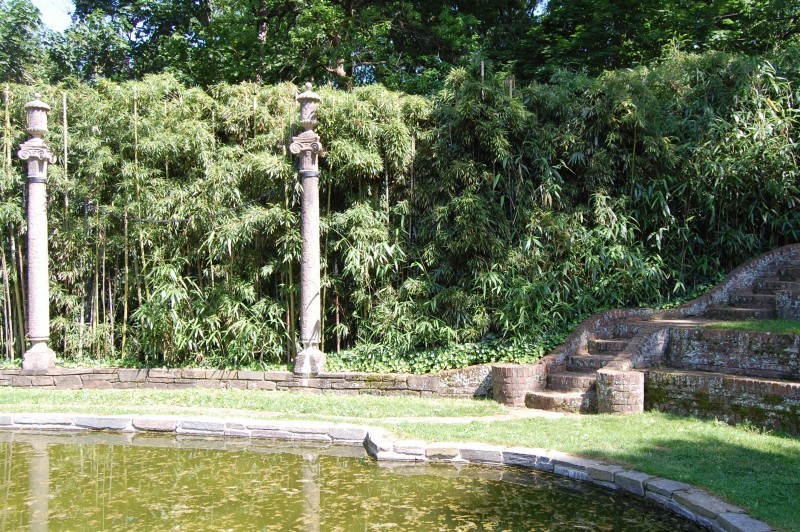
Lovers’ Lane pool and amphitheater. The seats were adapted from the “open-air theatre on the slopes of the Janiculum Hill at the Accademia degli Arcadi Bosco Parrasio. The shape of the theatre was copied from the one in Rome, but the slopes surrounding the Dumbarton theatre are far steeper than those on the Italian hillsides.”
“The whole arrangement surrounding the Lovers’ Lane pool is entirely controlled by the natural slopes of the ground and the deire to keep as many of the native trees as possible unhurt and undisturbed.”
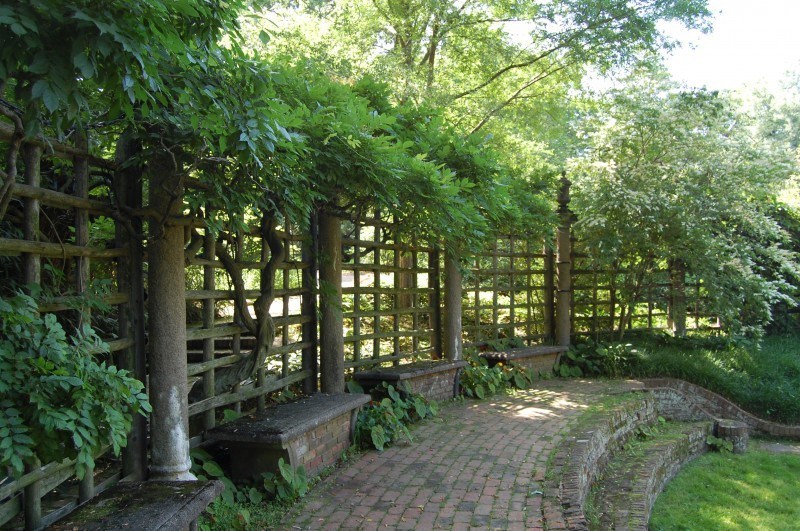
“In order to give seclusion to this little theatre, it has been surrounded by cast-stone columns, baroque in design. . . The columns are connected with a split natural-wood lattice in long horizontal rectangles.”
“The composition of the planting of the Herbaceous Border should be rather carefully chosen from material which is somewhat unusual in its character and harmonious in its color tones.”
“The high wall, on the west side with its latticed-brick balustrade, shows the difference in the material thought appropriate to use on account of the added distance from the house and its more formal lines . . . This high wall is an admirable place on which to grow certain climbing Roses, perhaps a Magnolia grandiflora, Clematis paniculata, and a wispy veil of Forsythia suspensa narrowing the steps leading from the Box to the Rose Garden Terrace.”
Beatrix would not be happy to find her fountains so spotless and pristine. She wrote, “two fountains are kept filled and playing during the summer season, and it is important that their curbs be allowed to become as mossy as possible, as, scrubbed and cleaned well, the curbs would look new and fresh and garish, whereas the fountains should appear to have been ‘found’ there and to be a part of the old plan.”
“. . . the structure of the tree (Fagus grandifolia) in winter is almost as beautiful as its summer color. It was clear that in any poistion so dominated by one magnificent tree, all the other planting must be secondary and as inconspicuous as possible.”
“The steps have been broken into three different flights in order to make the climbing not too laborious a process. Two-thirds of the way down the steps, a seat, under a lead canopy, is placed on the landing, and, when possible, is surrounded by pot [no, I don’t think she means THAT pot] plants which harmonize in color with those used in the garden.”
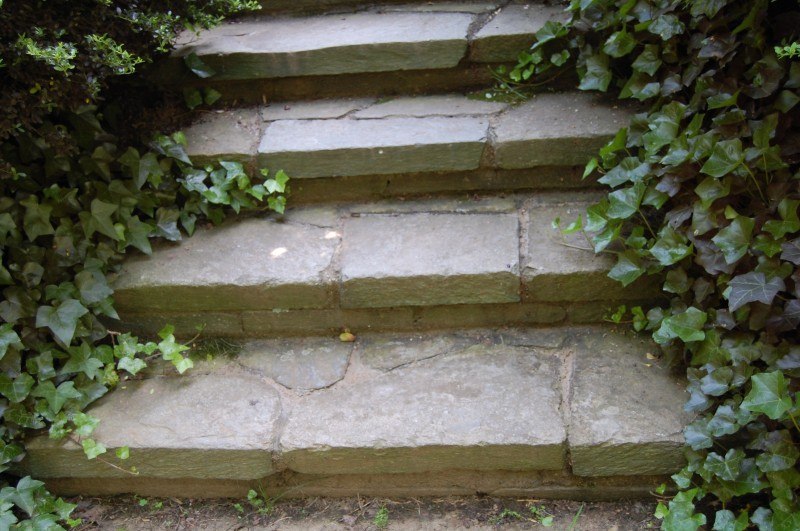
The irregular stones used in these beautiful steps signal that you are descending toward the “naturalistic” woodland and dell.
The Wisteria Arbor “was modified from a design of Du Cerceau (from his drawing of the garden of the Chateau Montargis). It is planted almost entirely with Wistaria, mainly of the lavender variety but with some few plants of white. The Wistaria Arbor is designed so as to be seen from below, so that the hanging clutches of the flowers will make a fragrant and lovely roof to the arbor.”
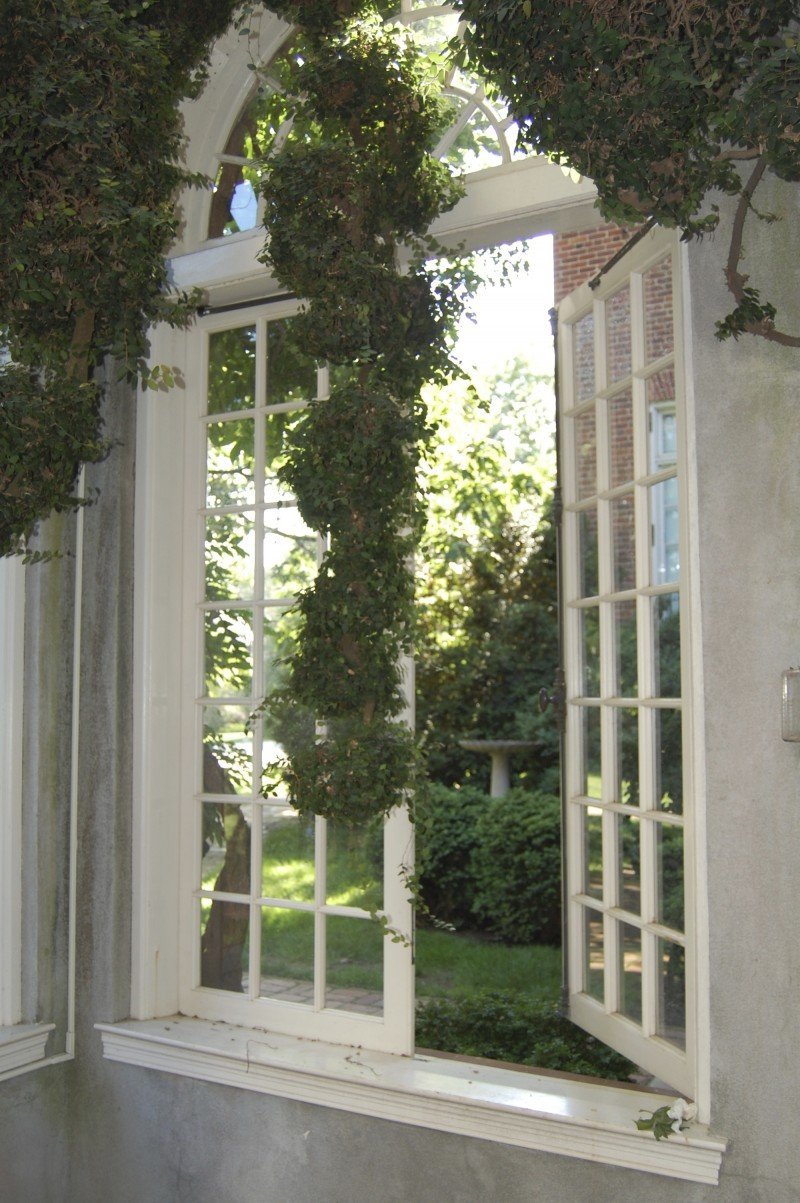
The orangery was built around 1810. Creeping Fig (Ficus pumila) climbs the walls and ceilings, and is pruned to form a pendant in front of each window.
Owner Mildred Bliss wrote, upon Beatrix Farrand’s death, “never did Beatrix Farrand impose on the land an arbitrary concept. She ‘listened’ to the light and wind and grade of each area under study. The gardens grew naturally from one another until now, in their luxuriant spring growth, as in the winter when leafless branches show each degree of distance and the naked masonry, there is a special quality of charming restfulness.”

